The Long Lifespan Of Photinia Red Robin
Photinia Red Robin hedges are known for their remarkable longevity, often thriving for decades when given the proper care. This evergreen hedge, distinguished by its vibrant red new growth, adds both colour and privacy to gardens, making it a popular choice in New Zealand for kiwis to seek out nice large grades of photinia red robin for sale ready for the first spring plantings.
The key to a healthy and long-lasting Photinia Red Robin hedge lies in proper planting and maintenance. These plants prefer well-drained soil and a sunny or partially shaded location. Ensuring the soil is rich in organic matter can also promote strong root development, which is crucial for the hedge’s long-term health. Regular watering, especially during dry spells, helps the hedge establish itself and maintain vigor.
Pruning plays a vital role in keeping Photinia Red Robin hedges healthy. Regular trimming encourages dense growth and maintains the vibrant red colour that makes this hedge so striking. It also helps in controlling the size of the hedge, preventing it from becoming too tall or wide, which can stress the plant.
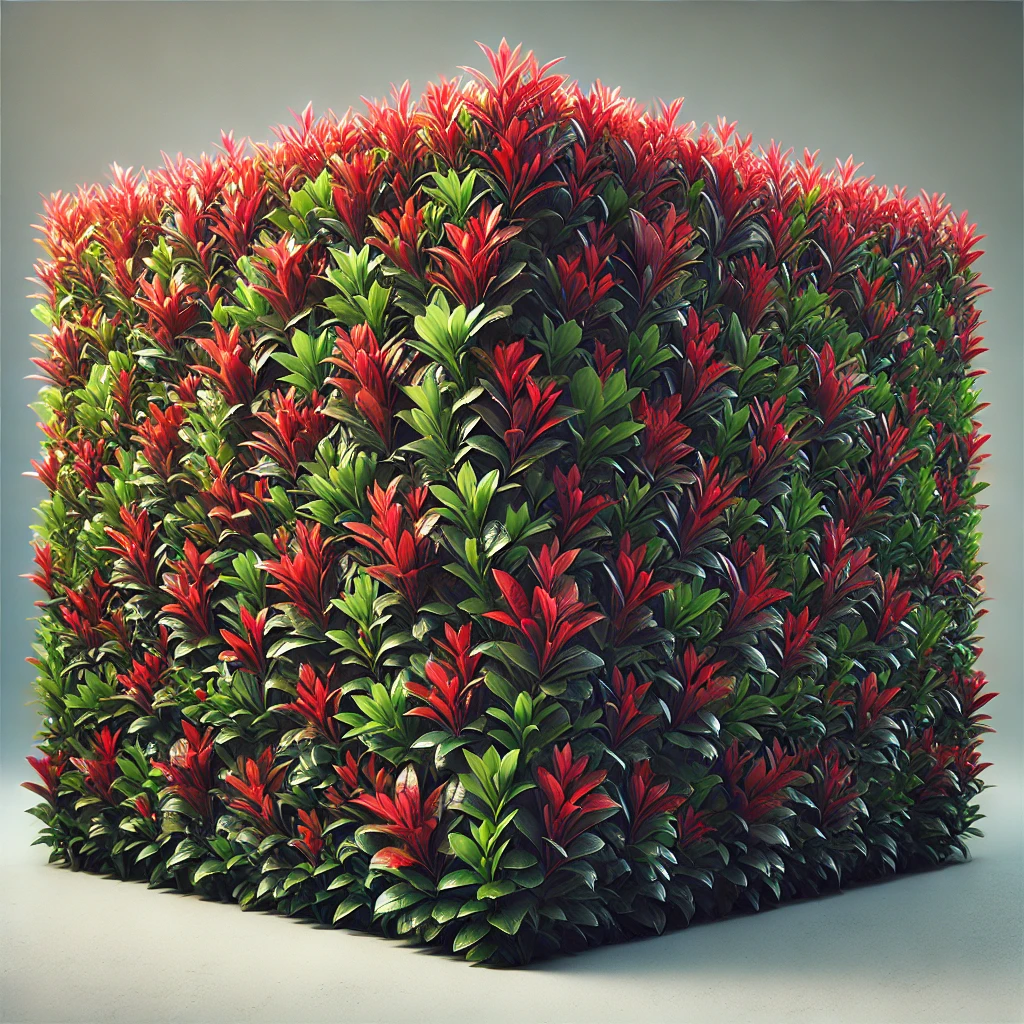
In New Zealand, where you will find large Photinia Red Robin for sale is readily available, these hedges can become a focal point in any garden with minimal effort. The plants are relatively low maintenance, requiring only basic care to thrive. However, it’s important to monitor for common issues like leaf spot or powdery mildew, which can be managed with appropriate fungicides and good air circulation.
Whether you’re considering a large Photinia Red Robin for sale or starting with smaller plants, investing in this hedge will provide you with a beautiful and durable addition to your landscape for many years. The combination of its vibrant colour, ease of care, and long lifespan makes Photinia Red Robin a fantastic choice for gardeners looking to enhance their outdoor space.
Common Diseases & Treatment For Photinia Red Robin Hedges
Photinia Red Robin hedges are a popular choice for gardeners due to their striking red foliage and robust growth. However, like all plants, they are susceptible to a range of diseases that can affect their health and appearance so when you are looking for Photinia Red Robin for sale always make sure they are disease free. Understanding these common issues and how to treat them is essential for maintaining a thriving hedge.
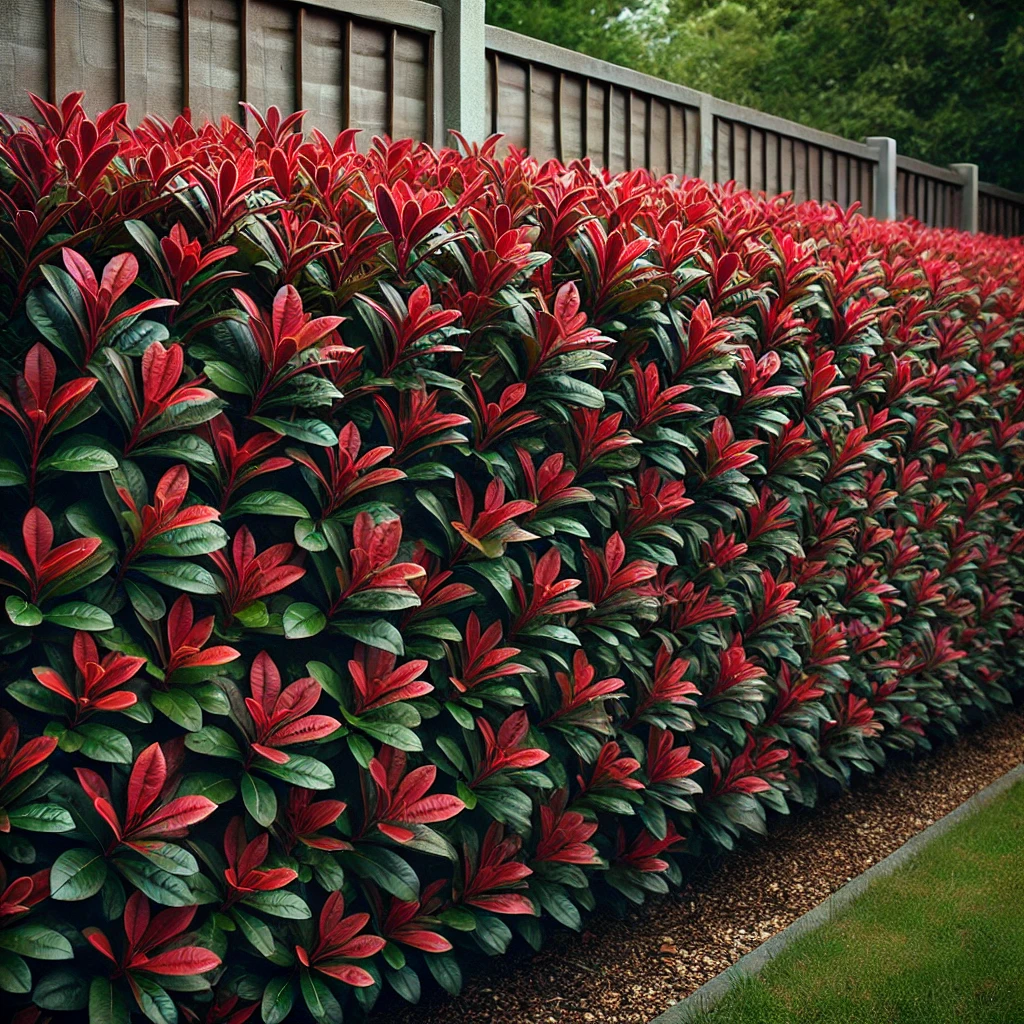
One of the most common diseases affecting Photinia Red Robin hedges is leaf spot, caused by the fungus Entomosporium mespili. This disease often appears as small red or purple spots on the leaves, which can grow larger and cause the leaves to drop prematurely. If left untreated, leaf spot can lead to significant defoliation, weakening the hedge and making it more vulnerable to other stresses. The best way to manage leaf spot is through regular monitoring and early intervention. Removing and disposing of infected leaves can help reduce the spread of the fungus. Additionally, applying a fungicide specifically designed to combat leaf spot can be effective, particularly during the wet seasons when the fungus is most active.
Another significant issue for Photinia Red Robin hedges is fire blight, a bacterial disease that can cause blackened, scorched-looking leaves and dieback of branches. Fire blight is particularly dangerous because it can spread rapidly through the plant, killing large sections of the hedge if not promptly treated. To manage fire blight, it’s crucial to prune out infected branches as soon as they are detected, making sure to cut well below the visible signs of infection. Disinfecting pruning tools between cuts is essential to prevent spreading the bacteria. In some cases, applying a copper-based bactericide can help control the disease, but this should be done carefully and as a preventive measure rather than a cure.
Powdery mildew is another common problem that can affect Photinia Red Robin hedges, particularly in humid conditions. This fungal disease appears as a white, powdery coating on the leaves and stems, which can inhibit photosynthesis and stunt the plant’s growth. While powdery mildew is rarely fatal, it can significantly affect the appearance and vitality of the hedge. To treat powdery mildew, improving air circulation around the hedge is crucial. This can be achieved by pruning overcrowded branches and ensuring that the hedge is not planted too densely. Fungicides can also be applied, but choosing one that is specifically designed for powdery mildew is important to ensure effectiveness.
In addition to these diseases, root rot can be a concern, particularly in poorly drained soils. Root rot is caused by various soil-borne fungi that thrive in waterlogged conditions, leading to the decay of the plant’s roots. Symptoms of root rot include yellowing leaves, wilting, and poor growth. If root rot is suspected, it’s important to improve the drainage around the hedge by amending the soil with organic matter or creating raised beds. In severe cases, affected plants may need to be removed and the soil treated with a fungicide before replanting.
Regular care and attention are key to preventing and managing these common diseases. For gardeners in New Zealand, where Photinia Red Robin for sale is readily available, choosing healthy plants from reputable nurseries is the first step in establishing a disease-resistant hedge. When selecting large Photinia Red Robin for sale, it’s important to consider the specific conditions of your garden, including soil type, drainage, and exposure to sunlight. Ensuring that the hedge is planted in a well-drained, sunny location can go a long way in preventing disease and promoting vigorous growth.
In addition to proper planting, maintaining good garden hygiene is essential for preventing disease. This includes regularly removing fallen leaves and debris from around the base of the hedge, which can harbor fungal spores and bacteria. Regular pruning is also important, not only for maintaining the shape of the hedge but also for improving air circulation and reducing the risk of fungal diseases.
For those dealing with persistent disease issues, it may be necessary to take a more proactive approach by applying preventive fungicides or bactericides during the growing season. However, it’s important to use these treatments carefully and according to the manufacturer’s instructions to avoid damaging the plants or the surrounding environment.
Finally, Photinia Red Robin hedges are generally hardy and resilient, they are susceptible to a range of diseases that can affect their health and appearance. By understanding these common issues and taking appropriate action, gardeners can maintain healthy, vibrant hedges that add beauty and structure to their landscapes. Whether you’re considering Photinia Red Robin NZ for your garden or dealing with an existing hedge, staying vigilant and proactive in disease management will ensure that your hedge remains a strong and attractive feature for years to come.
The History Of Photinia Red Robin In NZ
Photinia Red Robin has become a popular choice for gardeners and landscapers across New Zealand, offering vibrant colour and reliable growth in hedging. Originating from the Rosaceae family, the Photinia genus has been favoured globally for its ornamental appeal. However, it wasn’t until the introduction of the Red Robin variety that the plant truly took off in popularity, especially in regions like Auckland where you will always find a lot of photinia red robin for sale.
The Photinia Red Robin is distinguished by its bright red new leaves, which contrast strikingly against the older, dark green foliage. This colour change occurs with every flush of new growth, giving the plant a dynamic appearance throughout the year. Its appeal lies not only in its aesthetic but also in its practicality. The plant’s dense, bushy growth makes it an excellent option for creating privacy screens or windbreaks, making it a common choice for residential and commercial properties alike.
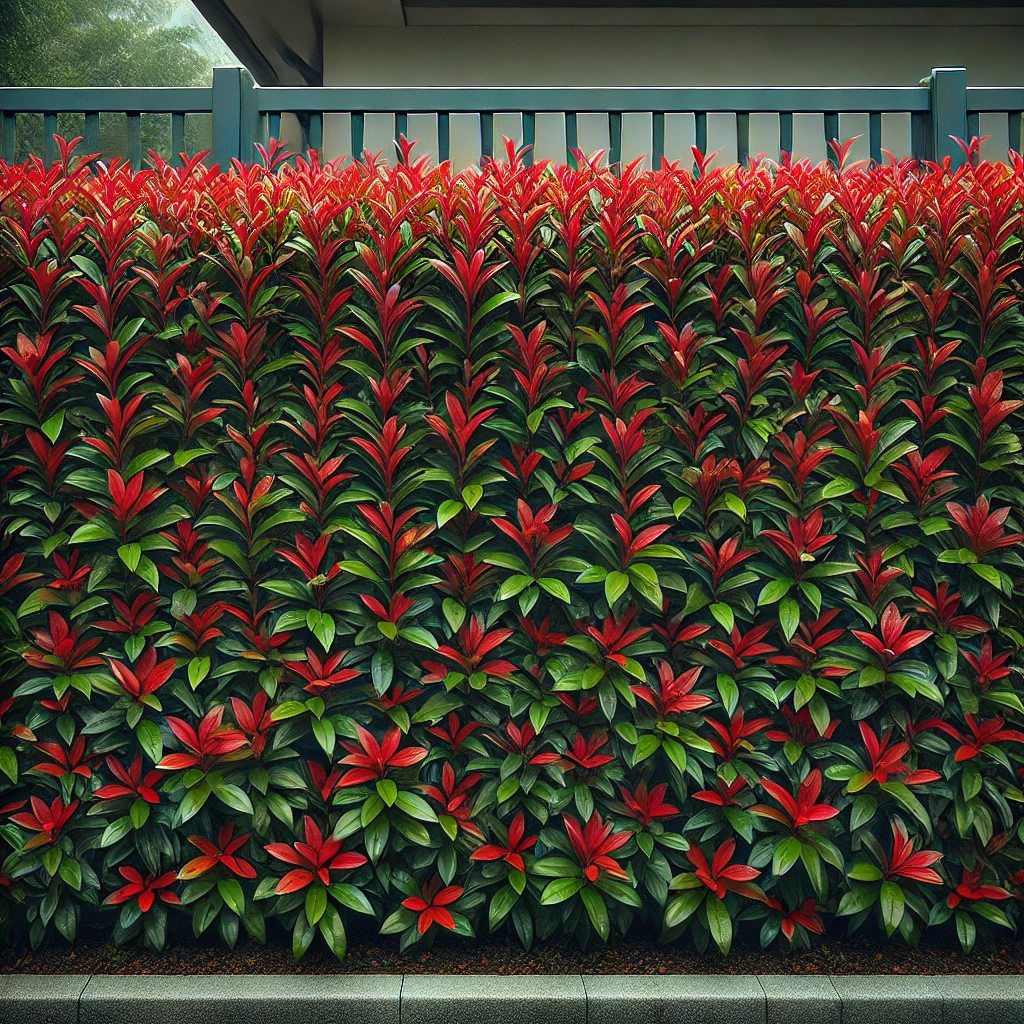
The history of Photinia Red Robin in New Zealand traces back several decades when it was first introduced as an ornamental plant. The species adapted well to New Zealand’s climate, thriving in the mild winters and relatively warm summers. This adaptability, combined with its fast-growing nature, quickly made it a favourite among local gardeners. As demand grew, nurseries across the country began to propagate the plant on a larger scale, ensuring its availability for those looking to add a splash of colour to their landscapes.
In Auckland, the popularity of Photinia Red Robin hedges has soared in recent years. With its ability to withstand the city’s coastal conditions and urban environment, it has become a go-to choice for those looking to create lush, vibrant boundaries around their properties. The hedges are particularly sought after in the suburbs, where they provide both aesthetic appeal and functional benefits, such as noise reduction and privacy.
For those searching for “Photinia Red Robin near me,” local nurseries and garden centres offer a wide range of options, from small starter plants to more mature specimens. Large Photinia Red Robin plants are especially popular among those looking to establish a hedge quickly. These mature plants, often available for sale at specialized garden centres, offer an instant impact, transforming a garden or property boundary almost overnight.
The surge in demand has led to an increase in the availability of large Photinia Red Robin for sale across Auckland. Many homeowners and landscapers prefer these larger plants for their ability to provide immediate coverage and aesthetic appeal. This trend is particularly noticeable in new housing developments, where Photinia Red Robin hedges are frequently used to define property lines and add greenery to the urban landscape.
Despite its popularity, caring for Photinia Red Robin requires some attention to detail. Regular pruning is essential to maintain its shape and encourage the vibrant red new growth that the plant is known for. However, the effort is well worth it, as a well-maintained Photinia Red Robin hedge can last for decades, providing year-round beauty and functionality.
In closing, the introduction and subsequent rise in popularity of Photinia Red Robin hedges in New Zealand, particularly in Auckland, highlight the plant’s versatility and appeal. Whether you’re looking for “Photinia Red Robin near me” or seeking out large specimens for sale, this plant offers a reliable and attractive solution for any garden or landscape project. Its combination of fast growth, vibrant colour, and practical benefits has secured its place as a staple in New Zealand’s gardening scene.
10 Reasons Why Photinia Red Robin Makes The Best Hedge
When it comes to selecting the perfect hedge for your garden, the Photinia Red Robin stands out as an unrivalled choice. This plant, with its vibrant red new growth and robust nature, offers more than just aesthetic appeal. It’s a hedge that marries beauty with practicality, making it an ideal choice for both residential and commercial landscapes. The surge in its popularity across New Zealand, especially in Auckland, underscores its versatility and the myriad benefits it brings to any outdoor space.

One of the key reasons why Photinia Red Robin is considered the best hedge you can plant is its striking appearance. The new leaves emerge in a brilliant red, which gradually matures into a glossy green. This ever-changing display of colour adds a dynamic element to any garden, providing year-round interest to those looking for photinia red robin nz. The contrast between the red and green foliage creates a visually stunning effect that few other hedging plants can match. This unique characteristic makes it a favourite among gardeners who seek to add a touch of vibrancy and warmth to their outdoor spaces.
However, Photinia Red Robin is not just about looks. Its practical attributes make it a standout performer in a variety of settings. The hedge is known for its dense growth, which makes it an excellent choice for creating privacy screens or windbreaks. Whether you’re in a bustling suburb of Auckland or in a more rural setting, this hedge provides a natural barrier that can help reduce noise, block unsightly views, and offer a sense of seclusion. Its thick foliage also serves as a windbreak, protecting more delicate plants from harsh gusts and creating a more controlled microclimate in your garden.
Another advantage of the Photinia Red Robin is its adaptability. This hedge thrives in a range of soil types and climates, from coastal regions to inland areas. Its resilience makes it particularly well-suited to Auckland’s variable weather conditions, where it can endure both the salty air of the coastline and the occasional cold snap of winter. Moreover, the plant’s drought-tolerant nature means it can withstand periods of low rainfall without sacrificing its lush appearance, making it a low-maintenance option for those who want a beautiful garden without constant upkeep.
For those searching for Photinia Red Robin near me, the availability of large Photinia Red Robin plants for sale offers an immediate solution for those looking to establish a hedge quickly. These mature specimens, often found at specialized nurseries and garden centres, can be planted to create an instant impact. A large Photinia Red Robin hedge not only provides immediate privacy and visual appeal but also helps to define property boundaries and add structure to the landscape. The rapid growth of this hedge ensures that even smaller plants will quickly fill out, creating a dense and impenetrable barrier within a few growing seasons.
Beyond its practical and aesthetic benefits, the Photinia Red Robin also requires relatively simple care, which adds to its appeal. Regular pruning is key to maintaining its shape and encouraging the vibrant red growth that is its hallmark. Pruning can be done at various times throughout the year, depending on the desired shape and size of the hedge. This flexibility allows gardeners to tailor the hedge to their specific needs, whether they prefer a formal, manicured look or a more natural, free-flowing appearance.
In addition to its resilience and ease of care, the Photinia Red Robin also boasts a long lifespan. When properly maintained, these hedges can thrive for decades, offering enduring beauty and functionality. This longevity makes them a wise investment for any property, as they continue to enhance the landscape year after year with minimal additional cost or effort.
In Auckland, where outdoor spaces are cherished and often serve as extensions of the home, the Photinia Red Robin has become a popular choice for creating private, serene garden areas. The hedge’s ability to thrive in this specific environment, coupled with its stunning appearance, has made it a staple in many Auckland gardens. Whether you’re looking to create a secluded retreat in your backyard or simply want to add a splash of colour to your property, the Photinia Red Robin offers an unmatched combination of beauty, practicality, and durability.
The Photinia Red Robin is the very best hedge you can plant, offering a blend of vibrant colour, dense growth, and adaptability that few other plants can rival. Whether you’re searching for Photinia Red Robin near me or seeking large Photinia Red Robin for sale to make an immediate impact, this hedge is a versatile and reliable choice that will enhance any garden. Its ability to thrive in diverse conditions, coupled with its low maintenance needs and long lifespan, ensures that it will continue to be a favourite among New Zealand gardeners for years to come.
The Most Famous Photinia Red Robin Hedges In NZ – A Closer Look At Our Old Red Giants
Photinia Red Robin hedges have become a defining feature in many gardens and public spaces across New Zealand, renowned for their vibrant red new growth and dense, evergreen foliage. These hedges, with their striking colour and hardy nature, have captured the hearts of gardeners and landscapers alike, making them a popular choice for creating beautiful, functional boundaries. Among the countless Photinia Red Robin hedges planted throughout the country, a few stand out as particularly famous, either due to their size, historical significance, or the impact they’ve had on their surroundings.
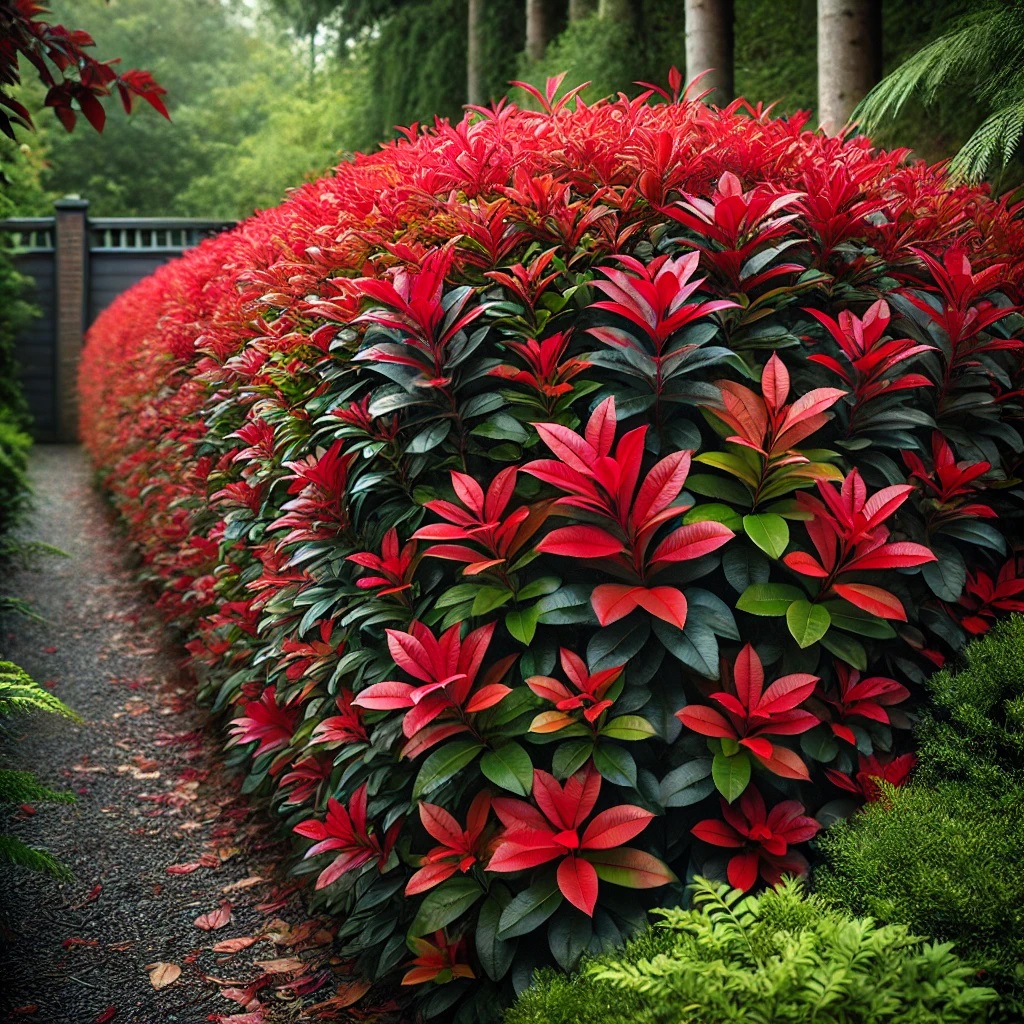
One of the most well-known Photinia Red Robin hedges in New Zealand can be found at the Auckland Botanic Gardens. This expansive garden, located in Manurewa, is a showcase for a wide variety of plant species, and the Photinia Red Robin hedge here is a prime example of how this versatile plant can be used to create stunning landscape features. The hedge runs along the perimeter of the formal garden section, providing a vivid backdrop to the carefully curated flower beds and ornamental trees. Its bright red new growth contrasts beautifully with the surrounding greenery, making it a favourite spot for visitors looking to capture the perfect garden photo. The hedge’s dense foliage also serves a practical purpose, offering a natural screen that enhances the sense of privacy and seclusion within the garden.
In the Wellington region, another famous Photinia Red Robin hedge can be found at the historic Trentham Racecourse. The racecourse, one of New Zealand’s oldest and most prestigious, is known not just for its horse racing but also for its beautifully maintained grounds. The Photinia Red Robin hedge that lines the entrance to the racecourse is particularly striking, with its vibrant red leaves creating a welcoming and grand entrance for visitors. The hedge has been meticulously trimmed and maintained over the years, ensuring that it remains one of the key visual features of the racecourse. Its presence adds a touch of elegance and formality to the venue, reflecting the history and tradition associated with the sport of kings.
Further south, in the Christchurch Botanic Gardens, the use of Photinia Red Robin for sale adds a modern twist to the garden’s classic layout. The gardens, which date back to the 19th century, have been continually updated with new plantings and designs, and the Photinia Red Robin hedge is a part of this ongoing evolution. This particular hedge is notable for its sheer size and the way it has been shaped to complement the garden’s existing structures. Its lush, red-tinged foliage provides a vibrant counterpoint to the more traditional plantings, drawing visitors’ attention and guiding them through the different sections of the garden. The hedge also plays a functional role, helping to define pathways and create a sense of order within the sprawling garden.
One of the largest and most impressive Photinia Red Robin hedges in the country can be found at a private estate in the Bay of Plenty. This hedge, which stretches for several hundred meters, is a testament to the impact that a well-maintained hedge can have on a landscape. The estate’s owners have invested considerable time and effort into cultivating the hedge, ensuring that it remains healthy and vibrant year-round. The result is a living wall of colour that not only enhances the beauty of the property but also provides a practical barrier against wind and noise. This hedge has become something of a local landmark, admired by neighbours and passersby alike for its stunning appearance and the care that has gone into its upkeep.
For those inspired by these famous Photinia Red Robin hedges and looking to create something similar in their own gardens, there are plenty of options available. Whether you’re searching for photinia red robin for sale, red robin for sale, or large photinia red robin for sale, there are numerous nurseries and garden centres across New Zealand that offer a variety of sizes and specimens to suit your needs. The versatility and hardiness of Photinia Red Robin make it an excellent choice for both small-scale gardens and large landscape projects, allowing you to create a hedge that is as functional as it is beautiful.
Photinia Red Robin hedges have become a beloved feature in many of New Zealand’s most famous gardens and public spaces. Whether used to frame a formal garden, create a grand entrance, or define the boundaries of a private estate, these hedges offer a unique combination of beauty and practicality. Their vibrant red new growth and dense foliage make them a standout choice for any landscape, and with the right care and attention, they can become a lasting and impactful part of any garden. As more people discover the benefits of this versatile plant, the demand for Photinia Red Robin hedges is likely to continue growing, ensuring that they remain a fixture in New Zealand’s gardening landscape for years to come.
The Correct Procedures For Trimming A Red Robin Hedge For Optimum Health Year Round
Trimming a Photinia Red Robin hedge is essential to maintaining its vibrant appearance and ensuring its long-term health. Known for its stunning red new growth, this hedge adds colour and structure to any garden. However, to keep it looking its best throughout the year, you must follow the correct procedures for trimming. Proper trimming not only enhances the hedge’s aesthetic appeal but also promotes healthy growth, preventing issues such as disease, pest infestations, and uneven growth.
The first step in trimming a Photinia Red Robin hedge is understanding its growth cycle. This plant is known for its rapid growth, particularly in the warmer months, which is when the new red leaves emerge. To maintain this striking appearance, trimming should be done regularly, but timing is crucial. The best time to trim a Photinia Red Robin hedge is during late spring and early summer, just after the first flush of new growth has begun to mature. Trimming at this time encourages the production of a second flush of red leaves later in the season, extending the period during which the hedge is at its most colourful.
Before beginning the trimming process, it’s important to ensure that your tools are sharp and clean. Dull tools can cause ragged cuts that may lead to disease, while dirty tools can introduce pathogens into the plant. Hedge shears are ideal for larger hedges, while hand pruners are useful for more detailed work, particularly on smaller sections or for removing individual branches.
Start trimming the hedge by working from the top down. This method prevents cut branches from falling onto areas that have already been trimmed, reducing the need for additional clean-up and minimizing the risk of damaging the lower sections of the hedge. When trimming, aim to create a slight taper with the base of the hedge wider than the top. This shape allows sunlight to reach all parts of the hedge, promoting even growth and preventing the lower sections from becoming sparse or bare.
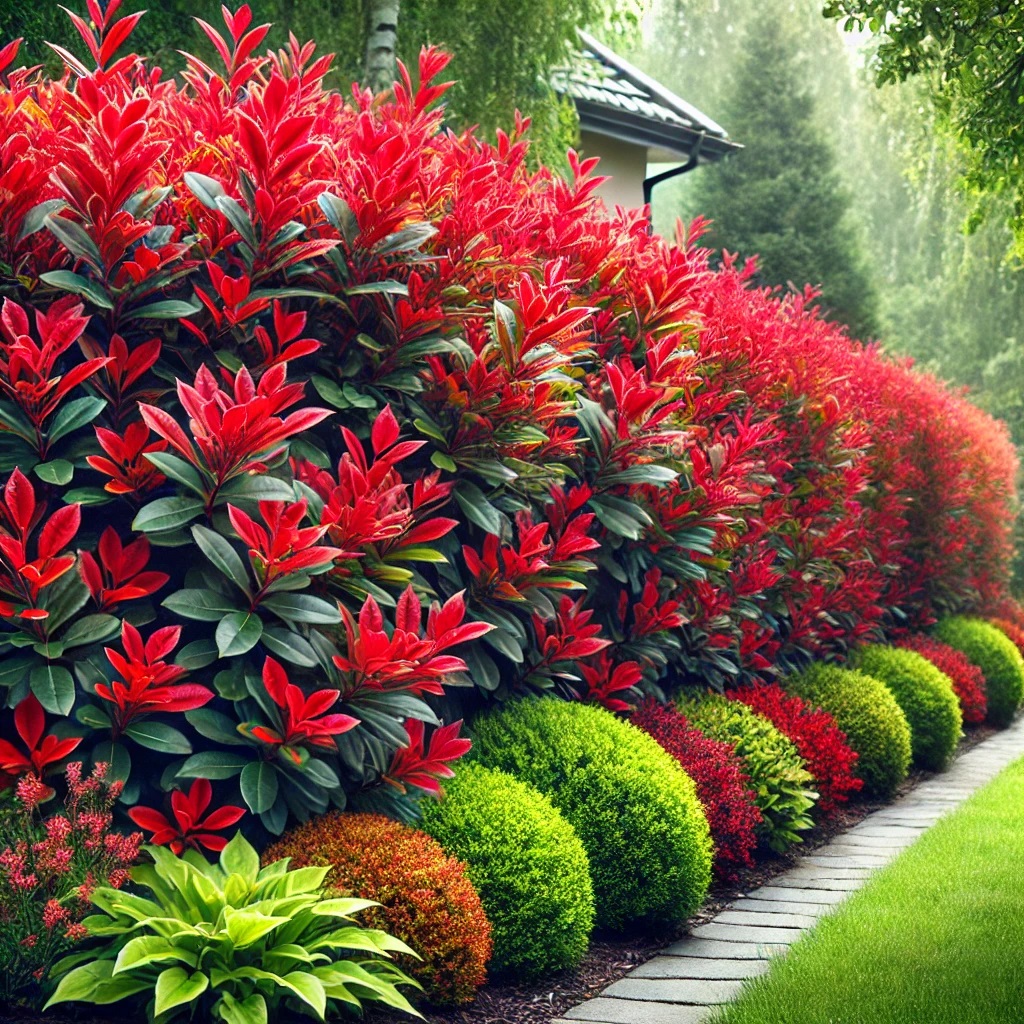
As you trim, it’s important to maintain a consistent shape. Photinia Red Robin is versatile and can be shaped into various forms, from formal, straight-edged hedges to more natural, flowing curves. However, whichever shape you choose, consistency is key. Uneven or irregular trimming can lead to a patchy appearance and may weaken the hedge over time. Using a string line or stakes can help guide your trimming and ensure that the hedge remains level and uniform.
In addition to regular trimming, it’s important to monitor the health of the hedge throughout the year. Most Photinia Red Robin for sale is generally hardy, but it can be susceptible to issues such as leaf spot or fire blight, particularly if the hedge is not trimmed properly. After trimming, inspect the hedge for any signs of disease, such as discoloured or wilting leaves. If any issues are detected, it’s crucial to address them promptly, either through appropriate treatments or by removing affected branches to prevent the spread of disease.
During the cooler months, particularly in late autumn and winter, trimming should be minimal. At this time, the plant’s growth slows down, and excessive trimming can stress the hedge, making it more vulnerable to cold damage. Instead, focus on light pruning to remove any dead or damaged branches, which can help maintain the overall health and appearance of the hedge without encouraging new growth that could be harmed by frost.
Watering and feeding also play a crucial role in maintaining a healthy Photinia Red Robin hedge. After trimming, particularly during the growing season, ensure that the hedge receives adequate water to support new growth. However, be mindful not to overwater, as waterlogged soil can lead to root rot. A balanced fertilizer applied in early spring and again after the first trimming can provide the nutrients needed to sustain vibrant growth throughout the year.
For those looking to establish a new Photinia Red Robin hedge, finding the right plants is essential. Searching for photinia red robin for sale, red robin for sale or large photinia red robin for sale can help you source healthy, well-established plants that will provide the best start for your hedge. Once planted, following the correct trimming procedures from the outset will ensure that your hedge grows strong and healthy, providing beauty and structure to your garden for years to come.
In conclusion, maintaining a Photinia Red Robin hedge requires regular trimming, careful monitoring, and appropriate care throughout the year. By trimming at the right times and using the correct techniques, you can keep your hedge looking its best, ensuring vibrant red growth and a lush, dense appearance. With the right approach, your Photinia Red Robin hedge will remain a standout feature in your garden, bringing colour and life to your outdoor space year-round.
Why Photinia Red Robin Is The Perfect Choice For A Hedge In Suburban Auckland
Photinia Red Robin has earned a well-deserved reputation as one of the top choices for hedging in suburban Auckland and across New Zealand. Its striking appearance, combined with its resilience and ease of care, makes it an ideal option for homeowners looking to create a beautiful and functional boundary in their gardens. This plant’s versatility and adaptability to New Zealand’s diverse climate conditions further solidify its position as a favourite among gardeners and landscapers alike.
One of the most compelling reasons to choose Photinia Red Robin for a hedge is its vibrant, year-round appeal. The plant’s new growth emerges in a bright red hue, creating a dramatic contrast against the mature, dark green leaves. This striking colour transition not only adds visual interest to any garden but also ensures that the hedge remains attractive throughout the year. In a suburban setting like Auckland, where space may be limited, having a hedge that provides such dynamic beauty is a significant advantage. The bright red foliage can brighten up a garden during the winter months, making the overall landscape more lively and inviting.
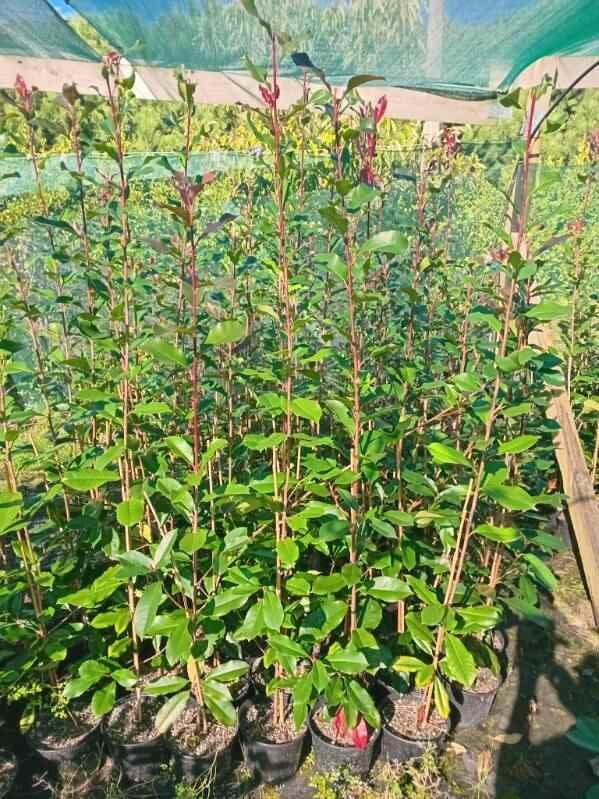
In addition to its aesthetic qualities, Photinia Red Robin is highly practical for hedging purposes. The plant grows densely, forming a thick, impenetrable barrier that is perfect for creating privacy and reducing noise from nearby roads or neighbours. This dense growth habit also makes it an excellent windbreak, protecting more delicate plants within the garden from harsh gusts. For suburban Auckland homeowners, where privacy and tranquillity are often at a premium, these qualities make Photinia Red Robin a particularly valuable choice.
Another reason why Photinia Red Robin is so well-suited to New Zealand’s suburban gardens is its adaptability to a wide range of soil types and environmental conditions. This plant thrives in well-drained soil and can tolerate both full sun and partial shade, making it versatile enough to fit into various garden designs. Whether you’re planting in the relatively mild climate of Auckland or in regions with more challenging conditions, Photinia Red Robin can be relied upon to grow robustly and maintain its health with minimal intervention.
For those seeking to establish a hedge quickly, Photinia Red Robin is available in various sizes, including large specimens that can provide immediate impact. Searching for Large Photinia Red Robin for sale Auckland will reveal numerous options for acquiring these mature plants, allowing homeowners to create a substantial hedge in a short amount of time. This is particularly appealing for those looking to enhance their garden’s privacy or aesthetic appeal without waiting several years for the hedge to reach full maturity.
In addition to its robust growth and adaptability, Photinia Red Robin is relatively low maintenance, which is a significant advantage for busy homeowners. Regular pruning is recommended to maintain the hedge’s shape and encourage the vibrant red new growth, but beyond that, the plant requires little in the way of special care. Its resistance to pests and diseases further reduces the need for ongoing maintenance, making it a convenient and cost-effective choice for suburban gardens.
The plant’s hardiness also makes it a reliable option for New Zealand’s variable climate. While some regions may experience occasional frosts, Photinia Red Robin is generally tolerant of cold conditions, and its evergreen nature ensures that it continues to provide shelter and greenery even during the winter months. This resilience, combined with its drought tolerance once established, makes Photinia Red Robin an excellent choice for gardeners across the country.
For those looking to add Photinia Red Robin to their gardens, there are many options available. Searching for Photinia Red Robin for sale will connect you with local nurseries and garden centres that offer a variety of sizes and cultivars, ensuring that you can find the perfect plants to suit your needs. Whether you’re in Auckland or elsewhere in New Zealand, Photinia Red Robin provides a versatile and reliable solution for creating beautiful, long-lasting hedges.
In conclusion, Photinia Red Robin is an outstanding choice for hedging in suburban Auckland and throughout New Zealand. Its vibrant, year-round appeal, combined with its practicality, adaptability, and low maintenance needs, make it a top contender for any garden. Whether you’re looking to create a private sanctuary in your backyard or simply want to add some dynamic colour to your landscape, Photinia Red Robin offers the perfect blend of beauty and functionality.
Important Preparations Before You Plant Your Red Robin Hedge
Preparing your soil properly is essential when planting and before you go out and buy a Photinia Red Robin for sale. It’s a vibrant and resilient choice for many New Zealand gardens. Especially in the suburbs of Auckland NZ. The right preparation not only ensures the immediate success of your hedge but also lays the groundwork for its long-term health and beauty. Photinia Red Robin, with its striking red new growth and hardy nature, thrives in well prepared soil that supports its vigorous growth and bright foliage. By taking the time to prepare your soil meticulously, you can create the perfect environment for these plants to flourish.

The first step in soil preparation is understanding the specific needs of Photinia Red Robin. These plants prefer well drained soil that is rich in organic matter, with a pH level between 6.0 and 7.0. Before you start digging it’s crucial to assess the current state of your soil. If your garden soil is heavy clay or sandy, it might need significant amendment to meet the ideal conditions for an eventual large Red Robin hedge. Begin by testing your soil’s pH with a home testing kit available from most garden centres. While you are there buying that check out their red robin for sale and you just might find some bargains. This whole pH step is essential, as soil that is too acidic or too alkaline can impede nutrient uptake and stunt your hedge’s growth. Red robin hedges never grow well if the soil pH is wrong.
If the pH of your soil is below the ideal range, it’s too acidic, and you’ll need to raise it by incorporating garden lime. On the other hand, if your soil is too alkaline, adding sulphur or organic matter such as compost can help lower the pH. Adjusting the pH to suit Photinia Red Robin’s preferences will encourage robust growth and vibrant foliage. It’s best to make these adjustments several weeks before planting your red robin for sale that you may have already purchased, allowing the soil time to stabilize and properly integrate the amendments.
Once you’ve adjusted the pH, it’s time to improve the soil structure. Photinia Red Robin thrives in soil that allows its roots to spread easily, so working organic matter into the soil is crucial. Start by digging a trench along the line where you plan to plant your hedge, making it about twice the width of the root balls and at least as deep. This will give you ample space to work the soil and ensure it’s well-prepared. If your soil is heavy and compacted, incorporate plenty of compost or well-rotted manure into the soil. These materials will improve aeration and drainage, making it easier for the roots to establish themselves.
For soils that are too sandy and drain too quickly, the addition of organic matter is equally important. It helps retain moisture and nutrients, providing a more stable environment for your hedge. Thoroughly mix the organic matter into the soil, ensuring that it is evenly distributed throughout the planting trench. This will create a consistent environment that encourages uniform growth along the entire length of the hedge.
Proper drainage is another critical factor for the success and creation of a large Photinia Red Robin hedge. These plants do not tolerate waterlogged conditions, which can lead to root rot and other serious problems. After improving the soil structure, assess the drainage by filling the trench with water and observing how quickly it drains. If the water takes more than a few hours to drain away, you may need to address drainage issues before planting. Consider raising the planting area slightly by adding a mound of well-drained soil or installing a French drain to carry excess water away from the roots. This step is particularly important in areas with heavy rainfall or poorly draining soils.
With the soil structure and drainage addressed, the next step is to incorporate a balanced, slow release fertilizer into the soil. Large Photinia Red Robin hedges benefit from a steady supply of nutrients, particularly during the establishment phase. Choose a fertilizer that is high in phosphorus to encourage strong root development, as well as one that provides the necessary nitrogen and potassium for healthy growth and vibrant foliage. Work the fertilizer into the top layer of soil, ensuring it is evenly spread along the trench where the roots will grow.
Watering the soil before planting is essential to creating the right environment for your large Photinia Red Robin hedge. The soil should be evenly moist but not waterlogged, providing the roots with the hydration they need without creating conditions conducive to rot. Water the trench thoroughly, allowing the moisture to penetrate deeply into the soil. This will help the plants settle in more quickly and begin establishing their roots as soon as they are planted.
When you’re ready to plant your Photinia Red Robin hedge, ensure that each plant is spaced appropriately. Depending on the size of the plants you’ve purchased, whether they’re smaller or larger specimens such as those often listed under large Photinia Red Robin for sale you’ll need to consider their mature size. Space them far enough apart to allow for their full growth, typically about 60 to 90 centimetres apart. Place each plant into the trench, ensuring that the top of the root ball is level with the surrounding soil. Backfill the trench with the amended soil, firming it gently around the roots to eliminate air pockets.
After planting, water the hedge thoroughly to help settle the soil and ensure good contact between the roots and the surrounding earth. This initial watering is crucial, as it helps the roots begin to establish themselves in their new environment. Apply a layer of mulch around the base of the plants, keeping it a few centimetres away from the stems to prevent rot. Mulch will help retain moisture, suppress weeds, and regulate soil temperature, all of which are important for the health and growth of your hedge.
In the weeks and months following planting, maintain consistent moisture levels in the soil, especially during dry periods. Monitor the hedge for signs of nutrient deficiency or stress and consider applying a balanced liquid fertilizer during the growing season to support its development. Regular watering, especially during the first year, is key to establishing a strong, healthy hedge.
For those planning to establish a Large Photinia Red Robin hedge, sourcing high-quality plants is as important as soil preparation. Searching for large photinia red robin for sale or large red robin for sale will help you find reputable nurseries offering robust plants. Investing in quality plants from the start, particularly larger specimens under large Photinia Red Robin for sale can give your hedge the best possible start and ensure that it grows quickly and healthily. We have these large grade specimens in stock currently. They are 1.8m tall for $45+gst each delivered and planted.
Preparing the soil properly for planting a large Photinia Red Robin hedge involves a series of carefully considered steps, each tailored to meet the specific needs of these vibrant plants. By adjusting the pH, improving soil structure, ensuring proper drainage, and incorporating the right nutrients, you can create the perfect environment for your hedge to thrive. With the right preparation, your large Photinia Red Robin hedge will grow strong and healthy, providing a stunning addition to your garden that will last for years to come.
The Kiwi Who Grew The Biggest Photinia Red Robin In The World
In a quiet corner of New Zealand, where the sheep outnumber the people and the gardens are lush and vibrant, a man named Graham took on a challenge that would leave horticulturists around the globe green with envy. Graham, a modest gardener with an impressive green thumb, managed to grow what is now recognized as the largest Photinia Red Robin hedge in the world. While others were content with their well-manicured, average-sized hedges, Graham had bigger ideas quite literally. His towering hedge is not just a local curiosity but a botanical marvel that has put his small town on the map.
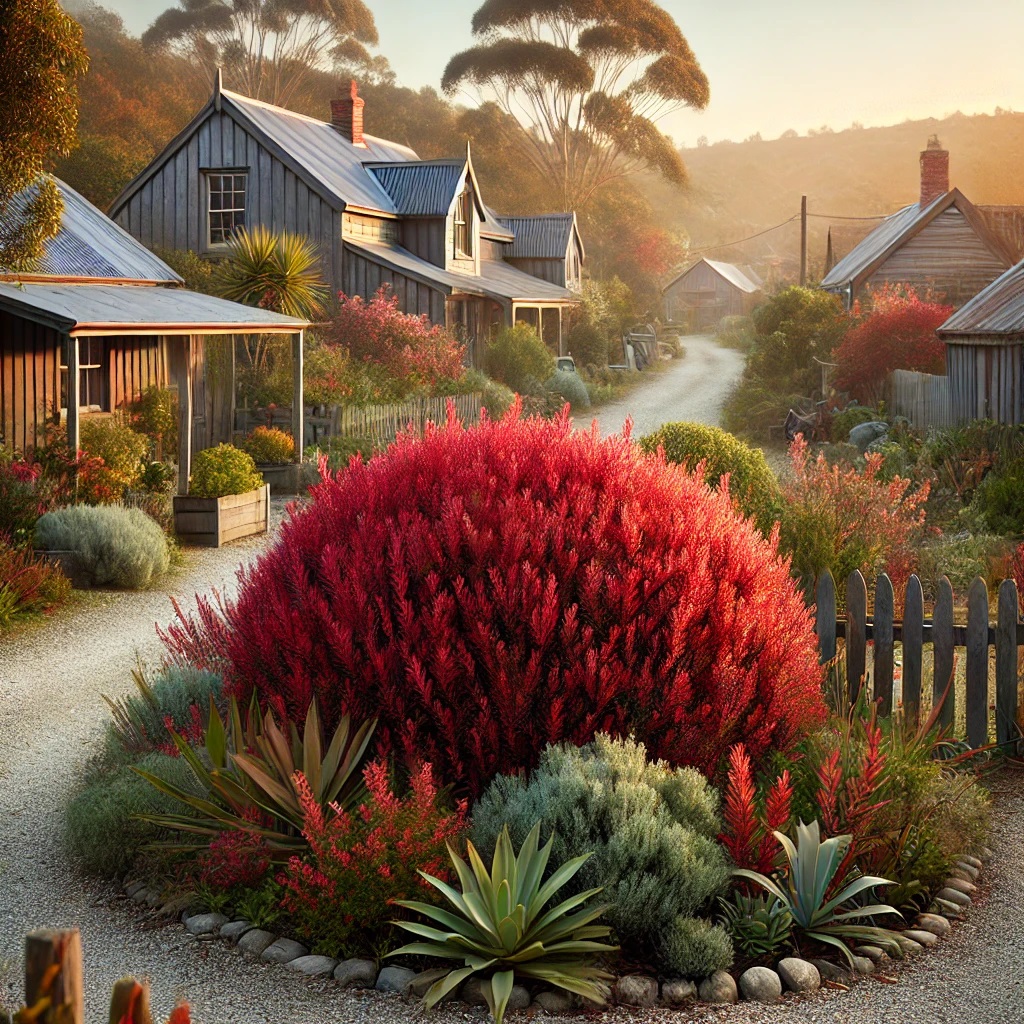
Graham didn’t set out to break records when he planted his first Photinia Red Robin. He was just looking for something to liven up his garden and add a splash of colour. But as any experienced gardener knows, once you start digging in the dirt, it’s easy to get carried away. Graham’s love for gardening quickly turned into an obsession, and his Red Robin hedge became his crowning achievement. But how exactly did he manage to grow this colossal hedge? The secret, as it turns out, lies in a combination of meticulous care, the right conditions. Plus a bit of good natured kiwi stubbornness.
The first step in Graham’s journey to growing the largest Photinia Red Robin hedge was choosing the right plants. He didn’t just pick up any old plants from the local garden centre. Graham sought out the healthiest, most vigorous specimens he could find. He knew that the foundation of a great hedge lies in the quality of the plants, so he went for the best. For anyone looking to follow in his footsteps, starting with top-notch plants is crucial. Searching for large Photinia Red Robin for sale can lead you to the kind of robust plants that will give your hedge a head start.
Once he had his plants, Graham turned his attention to the soil. Large Photinia Red Robin plants thrive in well-drained, fertile soil, and Graham was determined to give his hedge the perfect environment. He tested the soil pH and adjusted it until it was just right slightly acidic to neutral, around 6.0 to 7.0. Then he dug deep, literally and figuratively. He worked organic matter into the soil to improve its structure and drainage, ensuring that his plants would have plenty of nutrients and room to grow. Graham often joked that his hedge was spoiled, but he knew that a little pampering in the early stages would pay off in the long run.
Watering was another key element in Graham’s success. Photinia Red Robin plants need consistent moisture, but they don’t like to be waterlogged. Graham was meticulous about watering his hedge, making sure the soil stayed evenly moist but not soggy. He installed a drip irrigation system to ensure that each plant received the right amount of water, and he mulched generously to help retain moisture and keep the roots cool. His neighbours might have teased him for fussing over his hedge like it was a prize-winning rose, but Graham knew that attention to detail was what would set his hedge apart.
Pruning was perhaps the most important part of Graham’s routine. While some gardeners might dread the thought of trimming their hedges, Graham relished it. He trimmed his Red Robin hedge regularly, encouraging it to grow dense and full. He knew that proper pruning stimulates new growth, and with Photinia Red Robin, that means more of the stunning red leaves that make this plant so popular. Graham’s hedge grew taller and wider with each passing season, and his careful pruning helped it maintain its impressive shape and size.
But even with all the care and attention, Graham’s hedge didn’t become the world’s largest by accident. It took years of dedication, patience, and a bit of luck. The hedge thrived in New Zealand’s temperate climate, which provided the perfect conditions for growth. Graham also benefited from the fact that most Photinia Red Robin for sale are naturally fast-growing and hardy, able to withstand a range of conditions. Still, it was Graham’s unwavering commitment to his hedge that made it what it is today a living testament to the power of perseverance and a love for gardening.
Graham’s hedge has since become a local legend, drawing visitors from near and far who come to marvel at its size and beauty. It’s a source of pride not just for Graham but for his entire community. And while Graham is humble about his achievement, he’s always happy to share his tips with fellow gardeners. His advice? Start with quality plants, prepare your soil properly, water consistently, and don’t be afraid to prune. With a bit of dedication, you too could grow a hedge that’s the envy of the neighbourhood though you might have a hard time matching Graham’s record-breaking feat.
For those inspired by Graham’s story and looking to start their own Photinia Red Robin hedge, finding the right plants is the first step. Whether you’re searching for Red Robin for sale Auckland or even looking for larger specimens under large Photinia Red Robin for sale starting with healthy, vigorous plants will set you on the path to success. And who knows? With the right care and a bit of luck, you might just grow a hedge that’s big enough to rival Graham’s. After all, every great garden starts with a single plant and a gardener with a dream.
What Makes A Red Robin Hedge So Red
Photinia Red Robin hedges are a sight to behold, with their striking red new growth that seems to burst forth as if painted by nature’s finest brush. But what exactly makes these plants so red, and why does that coloration seem to come and go throughout the year? If you’ve ever found yourself admiring a Photinia hedge and wondering why it looks like it’s perpetually blushing, you’re not alone. Let’s dive into the science and a bit of gardening magic behind those crimson leaves.

The intense red coloration that Photinia Red Robin hedges are famous for is all thanks to a pigment called anthocyanin. This pigment is responsible for the red, purple, and blue hues in many plants, fruits, and flowers, and in the case of Photinia, it gives those fresh new leaves their fiery appearance. Anthocyanins act like sunscreen for the plant, protecting the tender new leaves from damage caused by harsh sunlight or UV radiation. It’s basically the plant’s way of putting on a pair of stylish sunglasses to protect itself from the elements. As the leaves mature and become hardier, the anthocyanins are no longer needed, and the leaves turn green, thanks to the production of chlorophyll, which takes over the job of converting sunlight into energy.
The dramatic colour shift isn’t just for show it serves a functional purpose. When those new leaves are bright red, the plant is telling the world (and any hungry bugs) that they’re not yet tough enough for snacking. The red coloration may also act as a deterrent for pests, signalling that the leaves are high in chemicals that make them less palatable. By the time the leaves are green, they’re fully developed and more capable of withstanding the rigors of life in your garden. So, in essence, the red colour is a natural defence mechanism, designed to help the plant thrive and protect itself during its most vulnerable stage.
Photinia Red Robin hedges are a marvel of design and functionality, but the level of redness can vary depending on several factors. Sunlight plays a major role in how red those leaves get. More light equals more anthocyanins, which means a hedge that’s positively glowing with crimson hues. In shadier spots, the plant will still produce some red leaves, but they may not be quite as vibrant. If you’re searching for red robin for sale Auckland and planning to add one to your garden, make sure to plant it where it will receive plenty of sunlight if you want to maximize that eye-catching red flush.
Soil conditions can also affect the level of redness. Photinia Red Robin plants prefer well-drained, slightly acidic to neutral soil. If the soil is too alkaline, it can affect the plant’s ability to produce the vibrant red leaves. Regular fertilization can help ensure that the plant has all the nutrients it needs to produce those show stopping colours. Gardeners looking for large Photinia Red Robin for sale should keep in mind that proper soil preparation can make all the difference when it comes to the health and colour of their hedge.
Interestingly, temperature can also play a part in how red the new leaves appear. Cooler temperatures, especially in the spring and fall, tend to enhance the red coloration. It’s as though the plant responds to the crisp air by intensifying its blush, adding even more visual appeal to the landscape. In warmer climates or during hot summers, the red may fade more quickly as the leaves mature. It’s this dance between light, soil, and temperature that makes Photinia Red Robin such an interesting and dynamic addition to any garden.
So, the next time you see a Red Robin hedge lighting up a garden, you’ll know that its vibrant hue isn’t just for show. That brilliant red comes from anthocyanins, working behind the scenes to protect the plant while giving it a signature look. If you’re inspired to add this colourful wonder to your own garden, searching for red robin for sale or large Photinia Red Robin for sale can set you on the right path. With the right conditions, you’ll have a hedge that not only provides privacy but also adds a splash of colour that will turn heads year-round.
Using Photinia Red Robin As A Natural Sound Barrier
Photinia Red Robin hedges are more than just pretty plants that add a splash of colour to your garden. They are also highly effective at reducing road noise, making them a popular choice for homeowners who live near busy streets or highways. You might be wondering how a row of plants can muffle the sound of traffic, but there’s a bit of science and a lot of practicality behind it. Red Robin hedges act as natural sound barriers, absorbing and deflecting noise, creating a quieter and more peaceful environment.

One reason Photinia Red Robin hedges excel at noise reduction is due to their dense foliage. The thick, evergreen leaves create a solid barrier that blocks sound waves from traveling freely. Sound, like light, can be reflected or absorbed, and these hedges do both. Their broad leaves and densely packed branches absorb some of the noise while the rest is deflected away, reducing the overall sound levels that reach your home. If you’re looking for red robin for sale in Auckland, you’re not just investing in a hedge for its aesthetic appeal—you’re also buying a natural, effective way to reduce the constant hum of traffic.
In addition to their ability to block noise, Photinia Red Robin hedges also have an aesthetic benefit that complements their soundproofing skills. Unlike walls or fences, which can feel rigid and industrial, a lush hedge adds beauty and privacy to your garden while doing double duty as a noise reducer. The leaves, which start bright red before turning green, bring a splash of colour, creating a vibrant backdrop for your outdoor space. Many Auckland homeowners searching for “red robin for sale Auckland” find that the hedge serves a dual purpose: it’s an attractive addition to their garden and an efficient way to dampen the sounds of city life.
Beyond just reducing noise, there are other practical benefits to having a Red Robin hedge. A quieter yard means you can actually enjoy your outdoor space without the constant interruption of cars whizzing by. Imagine sitting outside on a sunny afternoon, sipping tea and hearing birds chirp rather than the honk of horns. A well-placed Red Robin hedge allows you to escape the chaos of the street and relax in a peaceful environment. Plus, it gives you a bit more privacy, as the thick foliage can shield your yard from prying eyes as well as unwanted noise.
And it’s not just the sounds outside that benefit from a Red Robin hedge inside your home, you may notice a difference too. Road noise can easily infiltrate your walls and windows, making your living space feel less tranquil than it should. By planting a large Photinia Red Robin hedge along the perimeter of your property, you create an external sound barrier that can significantly reduce the noise pollution coming indoors. Searching for large Photinia Red Robin for sale is a great place to start if you want immediate impact, as mature hedges provide substantial soundproofing from day one.
In a city like Auckland, where road noise can be a constant companion, a Photinia Red Robin hedge offers a natural and aesthetically pleasing solution. Rather than constructing tall fences or thick walls, these hedges allow you to reduce noise while enhancing the look of your property. The vibrant red and green leaves add life to your garden, and as the hedge grows, it becomes an even more effective noise barrier. For anyone tired of the endless soundtrack of traffic, the Red Robin hedge provides a bit of quiet respite from the outside world.
Ultimately, the Photinia Red Robin hedge is more than just a decorative plant. It’s a hardworking, effective way to block out the noise and create a peaceful sanctuary in your yard. If you’ve been searching for red robin for sale Auckland know that you’re not just investing in beauty you’re investing in tranquillity. With one of these hedges, you’ll find that the only thing better than its good looks is the quiet it brings.
The Best Advice On What To Plant Around A Red Robin Hedge And Why
When you’ve invested in a beautiful Photinia Red Robin hedge, you’re not just planting a boundary you’re creating a backdrop for an entire garden design. The vibrant red new growth of a Red Robin hedge naturally draws attention, but it’s important to complement that beauty with the right plants nearby. If you choose wisely, you can create a harmonious garden where the hedge serves as both a centrepiece and a backdrop, enhancing the overall look of your outdoor space. So, what should you plant around your Red Robin hedge, and why?

First, you want to think about plants that will complement the bold red and green foliage of the hedge. The Red Robin hedge has a striking presence, so you don’t want to overshadow it with something too fussy or elaborate. Simple perennials like lavender, with its purple flowers and silvery foliage, pair beautifully with the rich red tones of Photinia. Lavender not only contrasts nicely with the hedge but also adds fragrance and attracts pollinators. Imagine sitting in your garden surrounded by the calming scent of lavender, with your hedge providing a colourful backdrop. Not only does this combination look fantastic, but it also brings a sense of tranquillity.
Next, consider incorporating evergreen shrubs that won’t compete with the Red Robin’s colour but will instead add texture and depth. Low-growing shrubs like boxwood or dwarf pittosporum are excellent choices. They add structure without overwhelming the eye and provide a neat, tidy look that balances out the hedge’s vibrant energy. These shrubs are perfect for creating a layered effect in your garden, with the hedge providing height and the smaller plants offering a cohesive underlay. Plus, evergreen shrubs ensure that your garden remains lush even during the cooler months, keeping everything looking fresh and lively year-round.
If you’re a fan of flowers, adding seasonal blooms around your Red Robin hedge is another great idea. Plants like hydrangeas, which come in soft pastels or bold blues, add a splash of colour without stealing the spotlight from the hedge. Their large, dramatic blooms offer a lovely contrast to the dense foliage of the hedge, and because they’re deciduous, they allow the hedge to shine in winter when the flowers have died back. For an extra burst of colour during spring and summer, you might also consider planting daylilies or irises. These low-maintenance perennials add vibrant colour and height variation that complements the hedge without overshadowing its brilliance.
Another great companion for a Red Robin hedge is ornamental grasses. Grasses like miscanthus or carex add movement to the garden and create a light, airy feel. The soft, swaying nature of grasses contrasts beautifully with the strong, bold lines of the hedge. When the wind blows, the grasses move gently, adding an element of motion to the otherwise solid structure of the hedge. And, as an added bonus, grasses are low-maintenance and drought-tolerant, making them an excellent choice for gardeners looking to minimize upkeep while maximizing style.
Of course, practical considerations should guide your choices as well. Red Robin hedges thrive in well-drained soil with plenty of sunlight, so it’s important to plant companions that enjoy similar conditions. Avoid plants that prefer constant shade or waterlogged soil, as they may struggle to thrive alongside your hedge. If you’re searching for red robin for sale Auckland or Large Photinia Red Robin for sale with plans to create a stunning garden centrepiece, think about the growing conditions in your yard and choose plants that will thrive in those same spots.
Finally, for those wanting to bring a bit of edible beauty to the garden, consider planting herbs like rosemary or thyme near your Red Robin hedge. These herbs love sunny, well-drained spots and will thrive alongside your hedge, providing both culinary and ornamental benefits. The woody stems and fragrant leaves of rosemary, in particular, offer a beautiful contrast to the hedge’s smooth, glossy leaves. Plus, you’ll always have fresh herbs on hand for cooking, making your garden not only a visual delight but a practical one too.
In conclusion, the best advice for planting around a Photinia Red Robin hedge is to choose plants that complement its colour and structure without overpowering it. Whether you’re opting for fragrant lavender, sturdy evergreen shrubs, bold flowering plants, or even practical herbs, make sure your selections suit the hedge’s growing conditions. With the right plants, your Red Robin hedge can become the centrepiece of a garden that’s as functional as it is beautiful. So, when you’re looking for red robin for sale, remember, you’re not just buying a hedge you’re setting the stage for an entire garden.
The Top 7 Things You Should Never Do To Your Red Robin Hedge
A Red Robin hedge, with its vibrant red new growth and easy-to-manage nature, is a popular choice for gardeners. However, as with any plant, maintaining a healthy and attractive hedge requires knowing what not to do. While it may seem like a low-maintenance plant, there are a few mistakes that can severely impact its growth and appearance. This guide covers the top five things you should never do to your Red Robin hedges and explains why avoiding these missteps is essential for keeping your hedge lush and vibrant all year round.
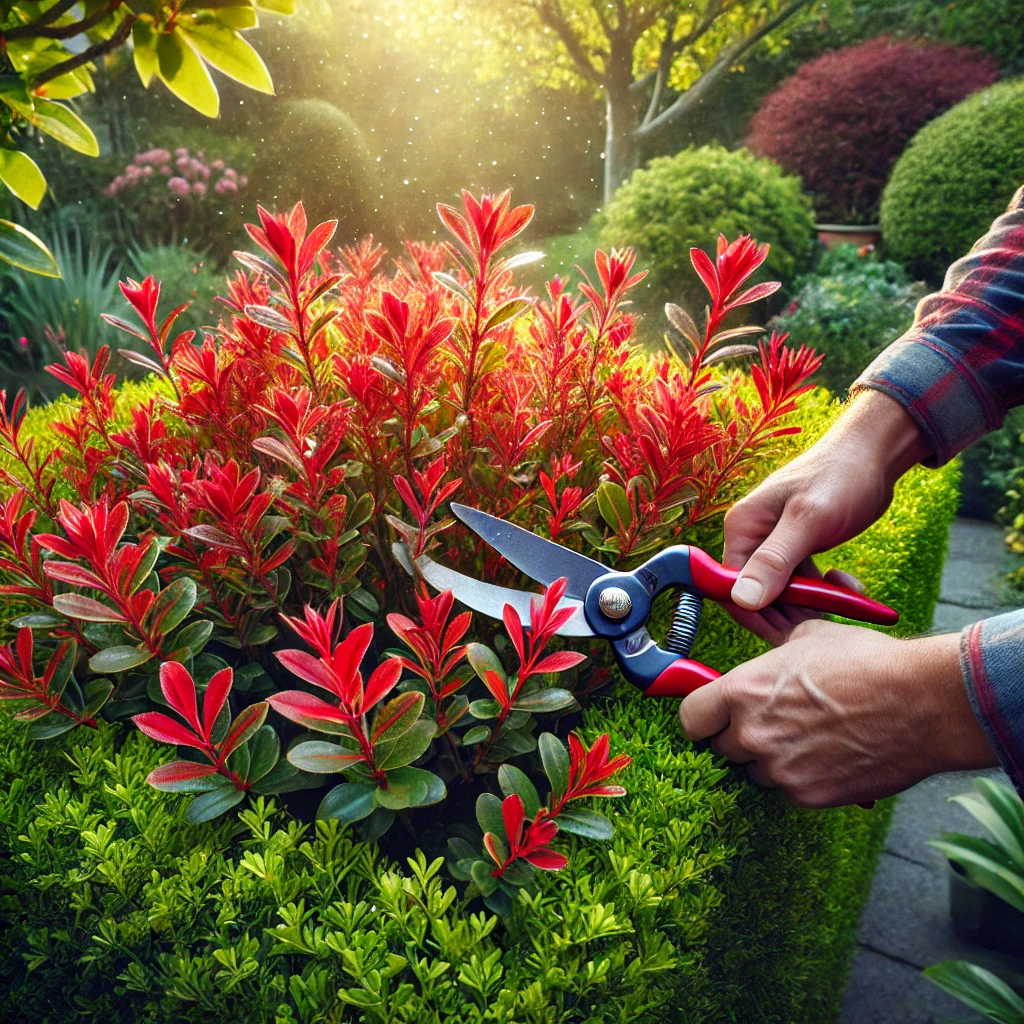
1. Never Prune in the Wrong Season
Timing is everything when it comes to pruning your Red Robin hedge. One of the biggest mistakes people make is pruning at the wrong time of year. Pruning in late autumn or winter can stimulate new growth at a time when the hedge is most vulnerable to frost. New growth will be soft and tender, meaning that any cold snap could cause damage, resulting in unsightly blackened or brown tips.
The best time to prune your Red Robin hedge is in early spring, just before the new growth begins to emerge. This will encourage a flush of healthy, red-tipped growth that makes this hedge so attractive. If you’re in the market for a new hedge, it’s worth searching for red robin for sale Auckland at the start of the season, so you can plant it at the optimal time and manage its growth from day one.
2. Never Overwater
Water is essential for any plant, but too much of it can be detrimental, especially for a Red Robin hedge. Overwatering can cause the roots to become waterlogged, leading to root rot and a gradual decline in the health of the hedge. Symptoms of overwatering can include yellowing leaves, soft and wilting growth, and stunted development.
The key to watering a Red Robin hedge is to strike a balance. While the hedge does need regular watering, particularly in its early stages of establishment, the soil should be allowed to dry out slightly between waterings. Water deeply but infrequently to encourage deep root growth, which will help the hedge become more drought-tolerant over time. If you’re just getting started and have found red robin for sale, be sure to ask about its watering needs in your specific climate and soil conditions.
3. Never Ignore Pests and Diseases
One of the most common mistakes gardeners make is assuming their Red Robin hedge is immune to pests and diseases. While this plant is generally hardy, it is susceptible to certain issues, such as leaf spot fungus and aphids. Ignoring the early signs of pest or disease problems can lead to significant damage, stunted growth, and even the death of the hedge.
To prevent problems, keep an eye out for discoloured spots on the leaves, wilting, or an unusual number of insects around the plant. Regularly inspecting your hedge for these signs can catch problems early before they become a more serious issue. Aphids, for example, can be managed with a strong jet of water or organic insecticidal soap. If you’ve recently found red robin for sale Auckland, it’s important to keep an eye on the health of your new plants, as they are more susceptible to pests during the establishment phase.
4. Never Over-Fertilize
It’s easy to think that more fertilizer means more growth, but with Red Robin hedges, this can backfire. Over-fertilizing can lead to a flush of overly rapid growth that is soft and weak. This type of growth is more prone to disease, pest damage, and weather-related injury, especially during colder months.
Instead, aim for a balanced feeding regime. Use a slow-release fertilizer in early spring to give the hedge the nutrients it needs for healthy growth. Be cautious with additional feeding throughout the year, as too much fertilizer can also disrupt the soil’s natural nutrient balance. If you’ve planted a new hedge after finding red robin for sale, be especially careful with its feeding, as young plants don’t need excessive amounts of fertilizer to thrive.
5. Never Trim Too Aggressively
While it’s important to keep your hedge looking neat and tidy, trimming too aggressively can have the opposite effect. Cutting back too much of the new growth at once can weaken the plant, especially if it’s done repeatedly. The vibrant red tips that make this hedge so popular emerge from new growth, so cutting it all back leaves you with a dull, green hedge instead of the striking two-tone effect you desire.
A good rule of thumb is to trim lightly and frequently, rather than performing one heavy cut. This will encourage more regular bursts of new growth, keeping the hedge looking full and colourful. If you’ve just bought a new hedge after finding red robin for sale Auckland, start slow with the pruning until the hedge is well-established. Frequent light trims will help maintain its shape while encouraging more vibrant, red growth.
Caring for Your Red Robin Hedge
Caring for a Red Robin hedge is all about understanding what not to do, just as much as knowing the right steps to take. Avoiding common mistakes like pruning at the wrong time, overwatering, and over-fertilizing can make a huge difference in the overall health and appearance of your hedge. Keep an eye out for pests and diseases, and remember that light, frequent trimming is always better than aggressive cutting.
If you’re thinking of adding a Red Robin hedge to your garden, start by looking for red robin for sale Auckland at the right time of year. With a little care and attention, your Red Robin hedge can become a striking feature in your garden, providing vibrant colour and a sturdy, reliable border for years to come.
Red Robin As A Coastal Hedge – Preparation & Benefits Of Red Robin
Red Robin, with its vibrant red foliage and hardy nature, is a fantastic option for coastal hedging. Its ability to withstand salt-laden winds, sandy soils, and the often unpredictable conditions found near the coast makes it a favourite among gardeners living by the sea. But like any plant, Red Robin requires the right preparation to thrive, especially when it comes to handling the unique challenges of sandy soils. In this guide, we’ll cover everything you need to know about using Red Robin as a coastal hedge, the preparation needed for planting in sandy soils, and the benefits it brings to a coastal garden.
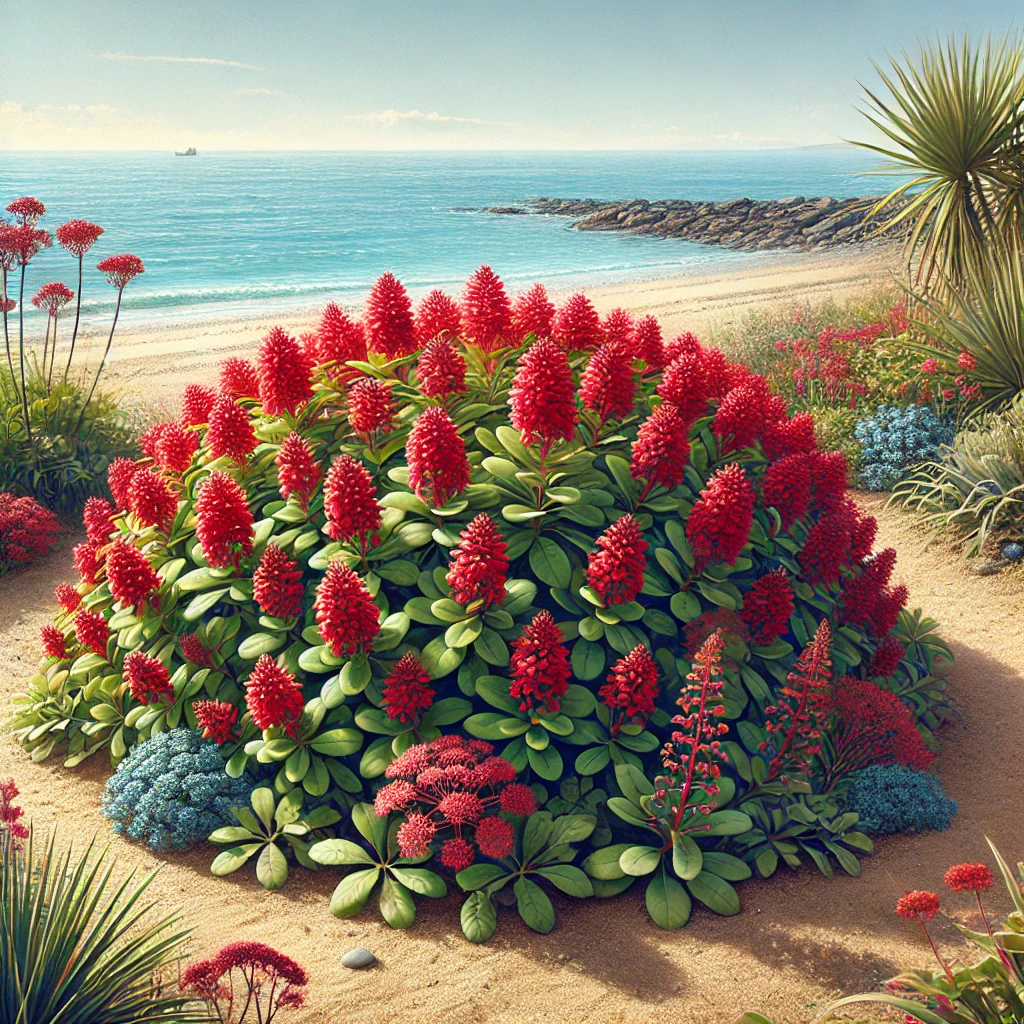
Why Red Robin Thrives in Coastal Gardens
Red Robin, also known as Photinia, is an ideal choice for coastal hedges due to its ability to tolerate wind and salt spray, conditions that would be problematic for many other hedge plants. It’s tough, leathery leaves are resistant to drying out in windy conditions, and its vibrant red new growth brings a welcome splash of colour to what can often be a muted coastal landscape. The combination of its visual appeal and its practicality makes it a popular hedge for homeowners near the beach.
Additionally, Red Robin’s growth habit is dense and compact, which provides excellent privacy and wind protection. For anyone seeking a hedge that offers both beauty and function, searching for red robin for sale Auckland will lead you to a plant that meets the needs of your coastal garden perfectly.
Preparing Sandy Soils for Red Robin
Sandy soils are common in coastal areas, and while they have good drainage, they also pose unique challenges. Sandy soils tend to be low in nutrients, have poor water retention, and can be prone to compaction. This means that extra preparation is required to ensure your Red Robin hedge has the best chance to establish and grow.
1. Enriching the Soil
Before planting Red Robin in sandy soil, it’s important to enrich the soil to improve its structure and fertility. Start by incorporating plenty of organic matter, such as compost or well rotted manure, into the planting area. This will help improve water retention and provide the necessary nutrients for your hedge to thrive. If you’ve found red robin for sale, make sure you ask the supplier about the best soil amendments for your particular region.
You’ll also want to consider adding some slow-release fertilizer to the soil mix. Since sandy soils can lose nutrients quickly, slow-release fertilizer ensures that your Red Robin hedge has a steady supply of nutrients over time.
2. Creating a Moisture Retention Layer
Another key step in preparing sandy soils is to create a moisture retention layer. Sandy soils drain quickly, and during hot, dry spells, your hedge could struggle to get the water it needs. Adding a layer of mulch around the base of your hedge will help retain moisture and keep the roots cool. This is especially important for coastal areas where the wind can dry out the soil more quickly.
Make sure the mulch doesn’t touch the base of the hedge directly, as this can cause issues with rot. Instead, leave a small gap around the stems and cover the surrounding soil with mulch to lock in moisture.
3. Avoiding Waterlogging
While sandy soils drain quickly, it’s important to avoid overwatering your Red Robin hedge, especially in the early stages of growth. Frequent, shallow watering can lead to poor root development and waterlogging, which can harm the plant. Instead, water deeply but less often, allowing the roots to grow deeper into the soil in search of water. This will also help the hedge become more drought-tolerant over time.
If you’ve recently purchased red robin for sale, it’s essential to monitor the watering needs closely, especially during the establishment phase, when the plant is more vulnerable to water stress.
Benefits of Red Robin in a Coastal Garden
Beyond its suitability for coastal conditions, Red Robin offers a range of benefits that make it an excellent choice for your seaside garden.
1. Salt Tolerance
Coastal gardens are often exposed to salty air, which can cause damage to many types of plants. Fortunately, Red Robin is highly tolerant of salt, making it well-suited to thrive in these conditions. Whether you’re looking for red robin for sale Auckland or elsewhere, this plant’s salt resistance means it will maintain its vibrant colour and healthy foliage even when exposed to coastal winds.
2. Wind Protection
One of the biggest challenges in a coastal garden is dealing with strong winds. These winds can dry out plants, cause breakage, and even uproot weaker species. Red Robin, with its dense and sturdy growth habit, acts as an excellent windbreak. It can help protect other, more delicate plants in your garden, creating a microclimate that allows them to flourish.
As your Red Robin hedge grows taller and thicker, it will provide even more protection against coastal winds, making your garden a more sheltered and enjoyable space. If you’ve just planted a hedge from red robin for sale, remember that it will take a little time to grow to full height, but the wind protection benefits will increase year after year.
3. Year-Round Visual Appeal
One of the most appealing aspects of Red Robin is its ability to look fantastic year-round. Its evergreen nature ensures that it provides structure and privacy in the garden even during the winter months. The bright red new growth in spring and early summer adds a splash of colour that complements the natural tones of the coastal environment.
By keeping your Red Robin hedge properly pruned and maintained, you can enjoy both its functional benefits and its aesthetic charm. For anyone looking to create a coastal hedge that offers more than just wind protection, searching for red robin for sale is a great way to get started.
The Ideal Coastal Hedge
Red Robin is an excellent choice for coastal gardens, thanks to its ability to thrive in windy, salty conditions and its vibrant, year-round visual appeal. Preparing sandy soils by enriching them with organic matter and mulch is essential for giving your hedge the best chance to establish and grow. Once properly prepared, the hedge will not only protect your garden from the elements but also provide a beautiful backdrop for your seaside retreat.
If you’re ready to add this hardy hedge to your coastal garden, consider searching for red robin for sale Auckland and start preparing your soil for a hedge that will bring both beauty and practicality to your outdoor space. With a little care and attention, your Red Robin hedge will thrive for years to come.
The Food And Eating Habits Of A Photinia Red Robin Hedge
Feeding your Photinia Red Robin hedge is a crucial part of keeping it healthy and vibrant throughout the year. This hardy and popular plant is known for its eye-catching red new growth, but without the right nutrients, that stunning colour can fade, and the plant can become susceptible to diseases.
Like any living thing, your hedge needs the right “food” to thrive. This guide will walk you through the best feeding practices and offer a comprehensive feeding plan for your Photinia Red Robin hedge.
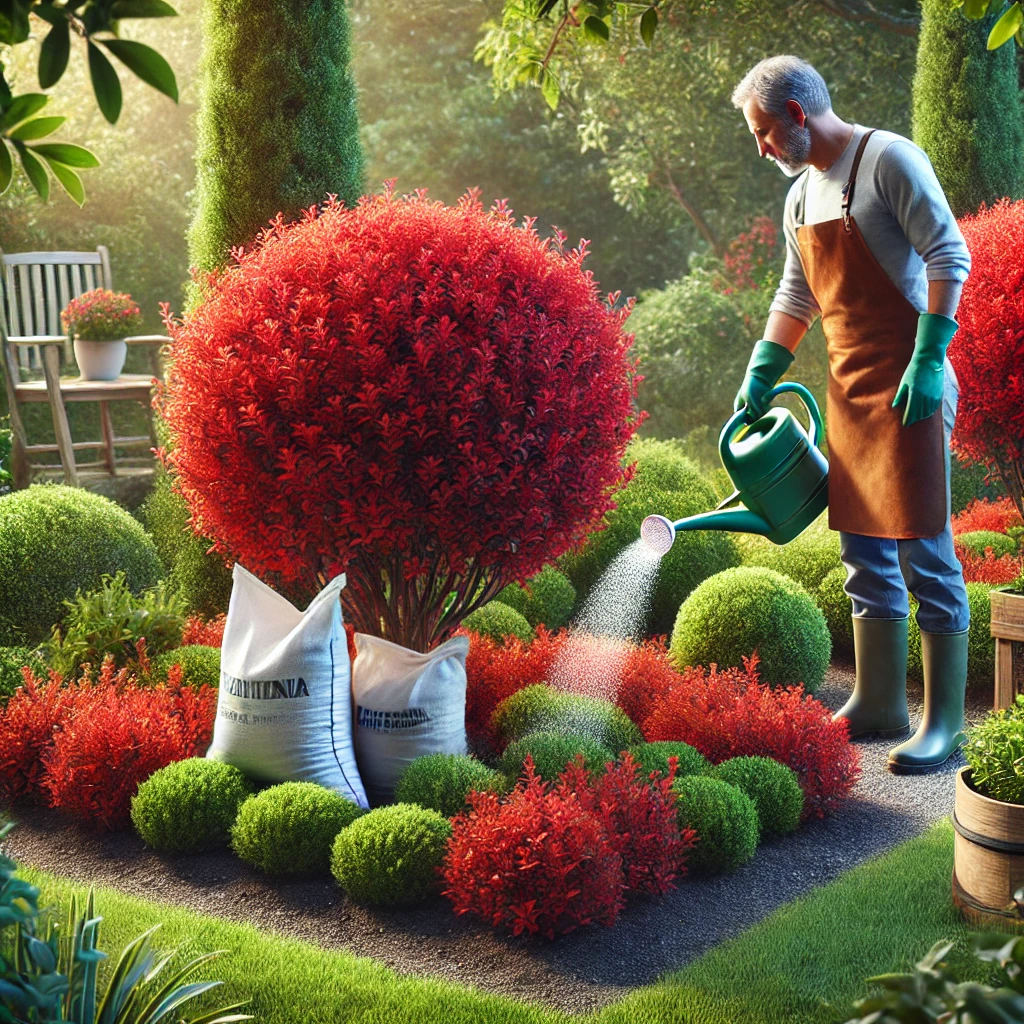
Understanding the Nutritional Needs of a Photinia Red Robin Hedge
The Photinia Red Robin hedge is a fast-growing evergreen that requires a good balance of essential nutrients to support its vibrant foliage. Nitrogen, phosphorus, and potassium are the primary nutrients it needs, along with a handful of micronutrients such as iron and magnesium. Nitrogen is particularly important for lush, leafy growth, while phosphorus supports strong root development, and potassium helps the plant resist diseases and stress.
If you’ve recently found Photinia Red Robin for sale Auckland and planted a new hedge, it’s important to remember that young plants need a little extra attention. During the first year, they require a gentle, steady feed to help them establish strong roots and promote healthy growth. Established hedges, on the other hand, benefit from a more robust feeding schedule to maintain their density and vibrant colour.
Feeding Plan for Your Photinia Red Robin Hedge
Spring – The Growing Season Kick-Off
Spring is the most important time for feeding your Photinia Red Robin hedge. This is when the plant wakes up from its winter dormancy and begins to put out fresh red growth. In early spring, use a balanced, slow-release fertilizer that is high in nitrogen to promote leafy growth. A 10-10-10 or 12-12-12 fertilizer works well at this stage. You’ll want to apply the fertilizer evenly around the base of the hedge, being careful not to let it touch the stems directly.
After applying the fertilizer, water the hedge thoroughly to help the nutrients reach the roots. If you’ve just purchased your hedge from Photinia Red Robin for sale, spring feeding will ensure that your new plants are off to a strong start.
Summer – Sustaining Growth
By summer, your Photinia Red Robin hedge should be in full bloom, with plenty of bright red leaves. To keep that growth going strong, give your hedge another round of fertilizer, but this time opt for a slow-release fertilizer with a lower nitrogen content. You don’t want to encourage too much soft, fast growth in the summer, as it can make the plant more susceptible to pests.
Instead, use a balanced fertilizer like 5-10-10 to support the overall health of the hedge and promote strong root systems. Apply this mid-summer feeding in late June or early July, again watering thoroughly after application.
If your hedge is starting to look a bit yellow or pale, you may want to add a dose of liquid iron to correct any iron deficiency. A quick trip to your local garden center in Auckland (perhaps while searching for Photinia Red Robin for sale Auckland) can help you find the right supplements.
Autumn – Preparing for Winter
As autumn rolls around, it’s time to prepare your hedge for the colder months. A potassium-rich fertilizer applied in early autumn will help your hedge build up its defences for winter. Avoid high nitrogen fertilizers at this stage, as you don’t want to encourage a lot of new growth that will be damaged by frost.
Instead, use a fertilizer with a ratio of 3-10-10 or something similar. This blend will help strengthen the roots and improve the overall hardiness of the hedge, ensuring it weathers the winter months without issue. If you’ve found Photinia Red Robin for sale and planted it in early autumn, this type of feeding is critical to help the young plants settle in before the first frost hits.
Winter – Rest and Recovery
During the winter months, your Photinia Red Robin hedge will enter a period of dormancy. This means no feeding is required. However, it’s still a good idea to keep an eye on the soil moisture levels. If the weather is dry, a light watering will help the roots stay healthy, even if the top part of the plant isn’t growing.
Common Mistakes and What to Avoid
One of the most common mistakes people make is overfeeding their Photinia Red Robin hedge, especially with nitrogen-heavy fertilizers. Too much nitrogen leads to soft, leggy growth that is more prone to disease and pests. It also reduces the vibrant red coloration of the new leaves, which is one of the main reasons people choose this hedge in the first place.
Another mistake is failing to adjust the feeding based on the time of year. Your hedge needs different nutrients at different stages, so always tailor your feeding plan accordingly. Finally, avoid applying fertilizer too close to the base of the hedge, as it can burn the roots and cause damage to the plant.
A Well-Fed Hedge for a Vibrant Garden
Feeding your Photinia Red Robin hedge correctly is key to maintaining its health and beauty year-round. By following this feeding plan and giving the hedge the right nutrients at the right times, you’ll ensure your hedge stays dense, vibrant, and disease resistant.
Whether you’ve just purchased your hedge from Photinia Red Robin for sale Auckland or you’ve been maintaining it for years, consistent feeding and care will keep it looking its best.
With the right food and some careful attention, your Photinia Red Robin hedge will thrive, bringing colour and structure to your garden for years to come.
Planting Photinia Around Pools & Ponds – A Complete Guide
Planting Photinia Red Robin hedges around swimming pools and ponds is an excellent way to enhance the beauty and privacy of your outdoor space. The bright red new growth of these hedges adds a vibrant splash of colour, and their dense, evergreen foliage provides natural privacy, shielding your pool or pond area from neighbours and wind. However, planting a hedge near water features requires careful consideration to ensure the plants thrive and don’t create unnecessary maintenance headaches. This guide will walk you through the key recommendations for planting Photinia Red Robin hedges around swimming pools and ponds.

Choosing the Right Location
Before you start planting, consider the location of your pool or pond in relation to the hedge. Photinia Red Robin hedges can grow to be quite large, with a mature height of around 4-5 meters if left unchecked. For most poolside or pond settings, it’s best to plant the hedge far enough from the water’s edge to avoid any overhanging branches. If planted too close, leaves and debris can fall into the pool or pond, increasing the cleaning required.
Ideally, place the hedge at least 1-2 meters from the water. This distance will also allow space for proper root development and help the hedge receive adequate sunlight and airflow, both of which are essential for keeping the foliage healthy. If you’ve recently purchased Photinia Red Robin for sale Auckland, take a good look at the layout of your space before digging those first holes to avoid crowding the hedge too close to the water.
Soil Preparation for Poolside Planting
Photinia Red Robin hedges are relatively adaptable when it comes to soil types, but when planting near a pool or pond, you need to pay extra attention to soil drainage. Pools often create microenvironments where the soil can be more compacted due to nearby paving or foot traffic. Make sure to loosen the soil where you plan to plant and mix in plenty of compost or organic matter to improve drainage and soil structure.
For areas around ponds, you’ll want to ensure that the soil is not too waterlogged. Photinia Red Robin does not do well in overly wet conditions, as the roots can rot if they sit in water for too long. Adding gravel or a drainage layer beneath the planting area can help prevent water buildup. If your local nursery has Photinia Red Robin for sale, ask for advice on the best soil amendments for your specific environment, especially if you live in an area with heavy rainfall.
Regular Maintenance to Keep the Area Clean
One concern when planting hedges near water features is debris management. Photinia Red Robin hedges do shed some leaves, especially during pruning or growth spurts. If your hedge is planted too close to the pool or pond, these leaves can fall into the water, making maintenance a chore. To mitigate this, regularly trim and prune your hedge to keep it well-shaped and prevent excessive leaf drop.
Use shears to cut back new growth in early spring and late summer. Not only will this help maintain the attractive red foliage, but it will also keep the hedge in check and reduce the amount of debris that ends up in the pool or pond. If you’ve found Photinia Red Robin for sale, invest in some good quality pruning tools, as regular trimming is essential to keep your hedge looking its best.
Avoid Harsh Pool Chemicals
When planting a hedge around a pool, it’s important to be mindful of pool chemicals. Chlorine, salt, and other chemicals used in pool maintenance can harm plants if they come into contact with the soil or foliage. To protect your hedge, make sure the hedge is planted far enough away from the pool to avoid splashes of chlorinated water. Additionally, if you’re backwashing your pool filter, direct the outflow away from the base of your hedge to prevent any chemical runoff from damaging the roots.
The same goes for ponds. If you treat your pond with algaecides or other water treatments, make sure the chemicals don’t leach into the hedge’s root zone. Keep an eye out for any yellowing or browning leaves, as this could indicate chemical stress. If you’ve recently purchased Photinia Red Robin for sale Auckland, you’ll want to pay close attention to how the hedge responds in the first few months, as young plants are more sensitive to environmental stressors.
The Benefits of Photinia Red Robin in Pool and Pond Areas
There are several reasons why Photinia Red Robin hedges are an excellent choice for pool and pond landscaping. Firstly, their dense growth makes them perfect for creating privacy screens, shielding your outdoor space from prying eyes. Their evergreen nature ensures year-round coverage, which is especially important for maintaining privacy in colder months when other plants might drop their leaves.
Another benefit is the splash of red that the new foliage brings in spring and summer. This vibrant colour adds a tropical or exotic feel to your poolside or pond area, making the space feel more inviting and lively. If you’ve recently discovered Photinia Red Robin for sale, consider planting a hedge around your pool to create a serene and beautiful retreat.
Conclusion: Enhancing Your Water Feature with Photinia Red Robin
Planting Photinia Red Robin hedges around swimming pools and ponds is an excellent way to add privacy, beauty, and structure to your outdoor space. By carefully choosing the planting location, preparing the soil, and maintaining your hedge regularly, you can create a vibrant and attractive hedge that enhances the aesthetic appeal of your garden without creating additional maintenance work.
For those in Auckland, checking for Photinia Red Robin for sale Auckland will give you a great starting point for finding healthy, robust plants that are well-suited to the local climate. With the right care, your Photinia Red Robin hedge will thrive, creating a stunning and functional backdrop to your pool or pond for years to come.
The Long Cultivation History Of Photinia Red Robin
The Colorful History of Photinia Red Robin: A Garden’s Favorite Shrub
Photinia Red Robin is more than just a pretty face in the garden. With its vibrant red leaves and easy-going nature, it’s no wonder this shrub has become a favourite across many landscapes, especially in Auckland. But what exactly is the story behind this eye-catching plant? Let’s dive into its history of cultivation and why it has become a go-to choice for gardeners everywhere.
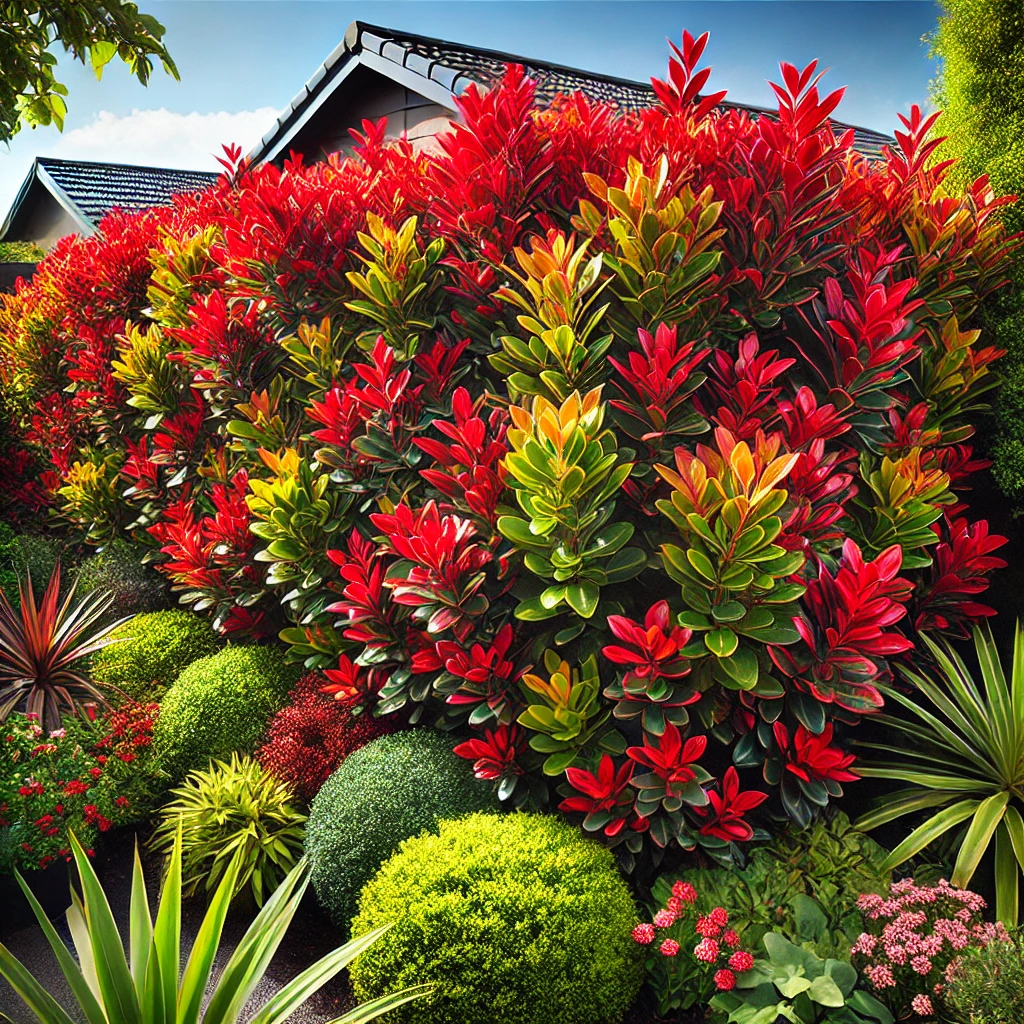
Where It All Began
The Photinia Red Robin we know and love today didn’t just pop up overnight. Its roots (pun intended) trace back to the Photinia genus, a collection of shrubs and small trees native to Asia. This group of plants belongs to the Rosaceae family, which means it shares some of its lineage with roses and apples. Pretty classy company if you ask me.
But Photinia Red Robin is actually a relatively recent addition to this family tree. It was bred in the mid-20th century, specifically for its striking foliage. The parent species of Photinia Red Robin, *Photinia serrulata* and *Photinia glabra*, had already made their mark in the world of horticulture, but gardeners wanted something more. They were craving that pop of colour, and Red Robin delivered with flying colours literally.
This hybrid took the best of both worlds, combining resilience, hardiness, and an unmistakable burst of red that sets it apart from the crowd. Fast forward a few decades, and this plant is now a staple in gardens, particularly in Auckland.
Why Auckland Loves Photinia Red Robin
If you wander around the suburbs of Auckland, chances are you’ll spot this shrub gracing many a front yard. Why the obsession with Photinia Red Robin in Auckland, you ask? For one, this plant thrives in temperate climates, making it a perfect match for New Zealand’s coastal weather. It’s tough, it’s durable, and, like all the best plants, it’s low maintenance. That’s a win-win for any gardener who doesn’t have hours to spend pruning and fussing over their hedges.
Speaking of hedges, let’s talk about how Photinia Red Robin became a superstar for those looking to create privacy. Thanks to its fast growth rate and dense foliage, it’s perfect for forming a natural, leafy barrier. It doesn’t hurt that it adds a splash of colour to what might otherwise be a plain green wall. So, when people search for Photinia Red Robin for sale, they’re likely envisioning a hedge that not only serves a purpose but also looks fantastic while doing so.
A Brief Guide to Cultivation
Photinia Red Robin is as easy going as it gets when it comes to cultivation. Gardeners will tell you that this plant thrives in most well-draining soils, but it does have a particular fondness for slightly acidic ground. As for sunlight, it’s pretty adaptable. Full sun is ideal, but if you have a shady spot, don’t worry—Photinia Red Robin can handle that too, although it might not get quite as vibrant.
Watering? Moderation is key. While it doesn’t require constant watering, Photinia Red Robin does appreciate a good drink now and then, especially in the early stages of its growth. Once established, it becomes much more drought-tolerant, which is another reason it’s so beloved in Auckland’s sometimes unpredictable climate.
The Many Uses of Photinia Red Robin
One of the best things about this plant is its versatility. While it’s often used in hedging, it can also stand alone as a statement piece in any garden. Its bright red shoots emerge in the spring, gradually turning to a deep, glossy green as they mature. This colour-changing act adds a dynamic element to any landscape, ensuring that it always has something new to offer.
For those on the lookout for Photinia Red Robin for sale, rest assured that this shrub is a worthwhile investment. Not only does it provide visual interest year-round, but it’s also relatively pest resistant. Sure, it might attract the occasional aphid, but who doesn’t have a few unwanted visitors in their garden? A bit of horticultural soap spray usually does the trick to keep things in check.
Fun Facts and Final Thoughts
Here’s a fun little tidbit: Photinia Red Robin gets its name from you guessed it its red leaves that resemble the chest of a robin bird. No actual robins were consulted in the naming process, but we can assume they’d be flattered by the comparison.
All in all, Photinia Red Robin is a garden hero for good reason. It’s reliable, beautiful, and a fantastic choice for those looking to spruce up their outdoor spaces with minimal effort. Whether you’re searching for Photinia Red Robin for sale to create a privacy hedge or just want to add a burst of colour to your garden, this plant has got you covered.
And for all of you gardeners in Auckland, next time you spot a thriving hedge of Photinia Red Robin, take a moment to appreciate the history, versatility, and sheer charm of this humble but mighty shrub.
Who knew that a plant could offer so much with so little fuss?
Photinia Red Robin in Pop Culture – The Popularity Of Red Robin Hedging
Photinia Red Robin in Pop Culture: The Unexpected Star of Gardens Everywhere
When you think of pop culture, plants aren’t the first thing that comes to mind. However, every now and then, a humble shrub takes center stage, and the Photinia Red Robin is one such surprise star. This vibrant, red-leaved beauty has found its way into our hearts, gardens, and believe it or not pop culture. From TV shows to celebrity gardens, Photinia Red Robin has made its mark, particularly in places like Auckland.
Photinia Red Robin’s Big Break in TV and Film
You’ve likely seen Photinia Red Robin on your screen without even realizing it. Its dense, colourful foliage makes it the perfect backdrop for many scenes, especially in suburban settings. The glossy green and vibrant red leaves look striking on camera, adding a splash of colour to what could otherwise be a boring hedge.

While it may not have a starring role in any blockbuster films, Photinia Red Robin has certainly had its moments in various TV shows. From cozy family dramas set in the suburbs to British garden shows, this plant has graced the small screen on numerous occasions. You’ll find it lining garden paths, creating natural privacy barriers, or just sitting pretty as a decorative element. In Auckland, where the plant thrives, it’s often featured in local television productions, standing tall in background shots.
Celebrity Gardeners and Their Love for Photinia
What do Beyoncé, Hugh Jackman, and Photinia Red Robin have in common? Well, they all have impeccable style though you might be more familiar with two of them. The truth is, many celebrity gardeners have taken a liking to this shrub. It’s not hard to see why. With its ever changing foliage, from fiery red to deep green, Photinia Red Robin keeps things interesting, much like a well-curated celebrity Instagram feed.
For those living in places with temperate climates, like Auckland, Photinia Red Robin is practically a gardening staple. Celebrities with sprawling estates and immaculate gardens often include this plant in their designs, either as a hedge or a stand-alone statement piece. And why wouldn’t they? The shrub is easy to care for, drought resistant, and looks stunning year round. It’s almost like the plant version of an A-list celebrity: low-maintenance, always on point, and a little flashy in the best possible way.
Photinia Red Robin in Gardening Trends
If you’re into gardening (or at least follow gardening trends on social media), you’ve probably noticed Photinia Red Robin making the rounds. Thanks to its versatility and eye catching appearance, it has become a bit of a trendsetter. In recent years, the rise of “natural but polished” garden aesthetics has pushed this plant to the forefront of stylish landscaping choices.
Homeowners looking to keep things chic but understated often search for Photinia Red Robin for sale as a solution. It brings a sense of structure to a garden while still feeling organic and wild. Its adaptability also makes it an excellent choice for different styles of gardens. Whether you’re into the manicured English garden look or prefer something more relaxed, Photinia Red Robin fits the bill.
In Auckland, where both modern and traditional garden designs flourish, Photinia Red Robin often plays a starring role. It’s a favourite for creating privacy hedges in sleek, minimalist outdoor spaces. Gardeners in this region can’t seem to get enough of it and frankly, neither can pop culture.
Photinia Red Robin’s Role in Eco-Friendly Landscaping
In recent years, there has been a growing trend toward eco-friendly gardening and landscaping, and Photinia Red Robin has naturally found its place in this movement. Its low water requirements and resilience make it a popular choice for those looking to reduce their environmental footprint without sacrificing aesthetics.
For example, if you’re a homeowner in Auckland who wants to create a sustainable garden, Photinia Red Robin for sale is a common search term. It’s drought-resistant once established, meaning less water usage always a plus in today’s environmentally conscious world. Plus, it’s great for local wildlife, offering cover and shelter for small birds and insects.
By choosing Photinia Red Robin, you’re not just keeping up with the trends but also making a responsible choice for your garden and the planet. It’s like wearing the latest fashion made from recycled materials you look good and feel good about your choices.
The Future of Photinia Red Robin in Pop Culture
With its already strong foothold in gardens and popular media, there’s no doubt that Photinia Red Robin will continue to pop up in unexpected places. Its iconic red leaves and robust growth habit ensure that it will remain a favourite among gardeners, landscapers, and even filmmakers.
As more people search for Photinia Red Robin Auckland, its influence is sure to grow even stronger. After all, this shrub ticks all the right boxes: it’s visually stunning, easy to maintain, and versatile enough to fit into almost any garden. Whether it’s featured on the latest hit show or quietly growing in your neighbour’s yard, Photinia Red Robin is a plant that’s here to stay.
So, the next time you’re scrolling through your favourite gardening Instagram or watching a suburban scene on TV, keep an eye out for this red-leaved superstar. Photinia Red Robin might just be the unassuming star of the show!
The Many Other Uses Of Red Robin – More Than Just Hedges
Beyond the Hedge: Creative Uses for Photinia Red Robin in Your Garden
When we think of Photinia Red Robin, the first image that comes to mind is often a beautiful, dense hedge that adds privacy and colour to our garden. But what if I told you that Photinia Red Robin has far more to offer than just being a hedge plant? This versatile shrub has plenty of tricks up its sleeve, and it can be used creatively in a variety of ways. If you’re looking for fresh ideas to use this plant, you’re in the right place!
Photinia as a Focal Point in Your Garden
One of the most striking features of Photinia Red Robin is its vibrant red foliage, especially in the spring when the new growth emerges. Why hide all that colour in a hedge when it can be the star of your garden? If you’re searching for Photinia Red Robin for sale Auckland, consider using it as a standalone statement piece.

Planting Photinia as a single specimen or in a cluster of three can create an eye-catching focal point. Whether placed near your patio, along a garden path, or in a mixed border, Photinia Red Robin can shine as the centrepiece. Its bright red leaves will contrast beautifully with the surrounding green plants, making it a conversation starter in your landscape.
Create a Living Wall
Sure, hedges are nice, but what if you’re looking to make a bigger statement? A living wall made of Photinia Red Robin could be your answer. Imagine a tall, vertical garden filled with layers of red and green foliage. Not only does it look amazing, but it can also help with insulation, noise reduction, and privacy.
Living walls are a growing trend, especially in urban areas where space is limited. By growing Photinia Red Robin vertically, you maximize your garden space while adding a striking visual element. Plus, this setup allows you to use Photinia in an unconventional yet stylish way. If you’re in Auckland and keen on exploring this idea, be sure to search for Red Robin for sale and get started on your living wall project!
Photinia as a Windbreak
Another excellent use for Photinia Red Robin, aside from the standard hedge, is as a windbreak. If you live in a windy area, such as near the coast or in an exposed garden, this plant can help shield your outdoor space. Its dense foliage and sturdy branches make it perfect for blocking harsh winds while still adding colour and beauty to your garden.
Planting Photinia as a windbreak in a more open layout where it’s not trimmed into a traditional hedge allows it to grow more naturally. This setup creates a protective barrier without the formality of a tightly pruned hedge. The leaves will catch the sunlight, offering both shelter and beauty in your garden.
Photinia as a Standalone Tree
Did you know that Photinia Red Robin can be pruned into a small tree? If you’ve ever looked for Photinia Red Robin for sale Auckland with the intention of planting a hedge, you might be surprised to learn that this shrub can also be trained into a striking ornamental tree.
By pruning the lower branches and allowing the top to grow freely, you can create a small tree with a bold red canopy. This adds vertical interest to your garden, and the tree like shape is a unique twist on the usual Photinia look. It’s perfect for adding height in a mixed border or as a standalone accent in the middle of your lawn.
Photinia as a Potted Plant
Looking for a way to spruce up your patio or balcony? Photinia Red Robin works well in large pots or containers. While it’s often used for larger landscape projects, its compact nature when pruned makes it suitable for container gardening. A potted Photinia can add a touch of elegance to smaller outdoor spaces.
Whether placed on either side of your front door or tucked into the corner of your deck, potted Photinia Red Robin adds a splash of colour and life to your space. Make sure to water it regularly, as container plants tend to dry out more quickly. Keep an eye out for Red Robin for sale when shopping for versatile plants to complement your outdoor area.
Photinia as a Backdrop for Flower Beds
If you’re a fan of colourful flower beds, then Photinia Red Robin might be the perfect plant to use as a backdrop. The shrub’s deep green and red hues offer a beautiful contrast to brightly coloured flowers, making it ideal for framing a bed of perennials or annuals.
Imagine your vibrant tulips, daffodils, or roses popping against the rich foliage of Photinia Red Robin. Not only does it provide visual interest, but it also adds texture and depth to your flower beds. If you’re keen to elevate the look of your garden, a quick search for Red Robin for sale will help you get started on this colourful backdrop.
The Creative Possibilities of Photinia Red Robin
So, whether you’re looking for Photinia Red Robin for sale Auckland to create a living wall, a standalone tree, or just to add some bright colour to your garden, this shrub has plenty of uses beyond the traditional hedge. It’s one of those rare plants that’s as versatile as it is attractive, making it a must-have for any garden enthusiast.
Who would’ve thought that a plant often confined to hedges could have so many other roles? Next time you’re thinking about freshening up your garden, don’t just plant it in a line think outside the hedge and let your creativity run wild!
Ultimate care for Photinia Red Robin – Tips For Growth And Care
The Ultimate Care Guide for Photinia Red Robin
Photinia Red Robin is a garden superstar, loved for its vibrant red foliage and versatility. While it’s often chosen for hedging, this hardy plant deserves some extra attention to keep it looking its best. Whether you’ve already brought home one or you’re searching for Photinia Red Robin for sale Auckland, this guide will help you master its care. From pruning to watering, and everything in between, let’s break down the essentials to keep your Photinia thriving.
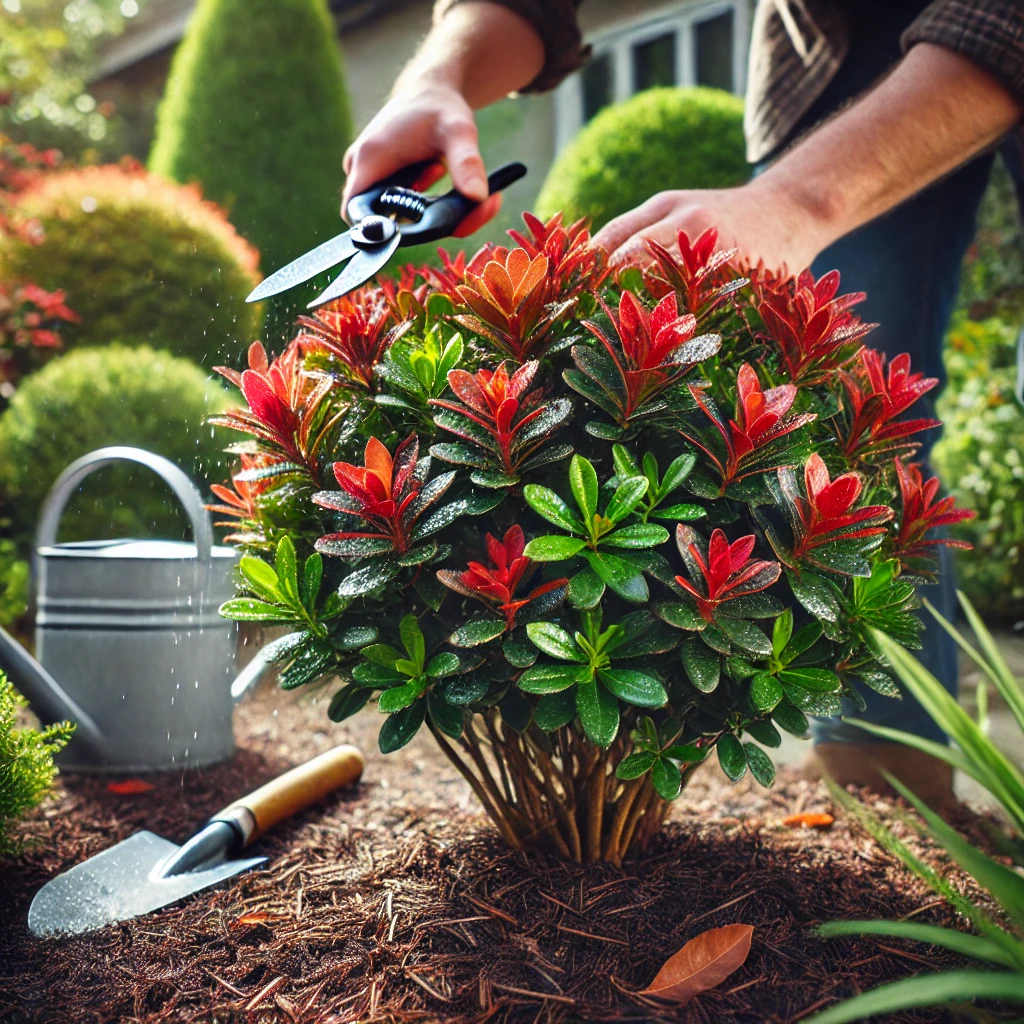
Position and Light
The first thing to consider when planting your Photinia Red Robin is location, location, location! This shrub prefers a spot with plenty of sunlight. Ideally, you should plant it in full sun to partial shade. If you’re in Auckland, where the temperate climate suits this plant perfectly, your Red Robin will flourish in most garden positions.
While it can tolerate some shade, planting it in a spot with at least 4-6 hours of direct sunlight daily will bring out the vibrant red leaves it’s famous for. A shady spot might lead to duller foliage, so give it some rays for a real showstopper. When searching for Red Robin for sale, make sure you’ve got a sunny spot ready.
Soil Requirements
Photinia Red Robin isn’t too fussy when it comes to soil, but it does prefer well-draining soil that’s slightly acidic. Sandy loam or clay soil can work well, as long as it doesn’t stay soggy after rain. If you’re unsure about your soil’s drainage, test it by digging a small hole and filling it with water. If the water sits for hours, it’s time to improve the drainage with some compost or organic matter.
For those planning to plant in containers, make sure to use a high quality potting mix to provide adequate drainage. Whether you’ve found Photinia Red Robin for sale Auckland or you’re planting an already-established shrub, soil quality will make a world of difference in its overall health.
Watering Regime
Photinia Red Robin is fairly drought tolerant once established, but like all plants, it needs regular watering during its first year. Newly planted Photinia should be watered deeply, at least once a week, especially during dry spells. Once it matures, you can dial it back to once every two weeks, depending on the rainfall.
Be mindful not to overwater your Photinia. Soggy roots can lead to fungal issues, which is something you definitely want to avoid. For container-grown Photinia, the rule of thumb is to water when the top inch of soil feels dry. In hotter Auckland summers, this might mean a bit more frequent watering.
Pruning Tips
Pruning is key to keeping your Photinia Red Robin looking its best. The good news? It’s not complicated! Pruning should be done in late spring or early summer, after the first flush of red leaves. Regular pruning encourages new growth, keeping the plant full and bushy.
For a formal hedge, trim it a couple of times a year to maintain the shape. If you’re growing it as a standalone specimen or tree, just remove any dead, damaged, or crossing branches. Don’t be afraid to prune back hard if the plant becomes too leggy Photinia is tough and will bounce back quickly with vibrant new growth.
A note of caution: always use clean, sharp tools when pruning to prevent the spread of disease. Once you’ve found Red Robin for sale and planted it, a little regular pruning goes a long way in keeping it looking vibrant.
Fertilising for Success
While Photinia Red Robin isn’t a heavy feeder, it does appreciate a boost of nutrients in the spring. Use a slow release balanced fertiliser that’s rich in nitrogen to encourage leafy growth. Applying it just before the growing season kicks off will help the plant produce those stunning red shoots that make it so popular.
You can also top-dress with compost or well-rotted manure for a more organic approach. Spread it around the base of the plant but avoid letting it touch the stem. If you’re in Auckland and have just picked up a Photinia Red Robin, fertilising in the first spring after planting will give it the energy it needs to establish strong roots and vibrant foliage.
Mulching and Pest Control
A layer of mulch around the base of your Photinia Red Robin will help retain moisture and keep weeds at bay. Use organic mulches like bark chips or straw, applying a 2-3 inch layer around the base. This not only keeps the soil moist but also protects the roots during hot Auckland summers.
As for pests, Photinia Red Robin is relatively pest-resistant, but you might occasionally spot aphids or scale insects. A quick spray with horticultural oil or insecticidal soap should keep them under control. Keep an eye out for any signs of fungal diseases like leaf spot, especially during wetter months. Pruning for good air circulation and avoiding overhead watering helps prevent this issue.
General Care and Maintenance
One of the best things about Photinia Red Robin is that it doesn’t demand constant care. However, like all plants, it appreciates a bit of TLC from time to time. Remove fallen leaves around the base to prevent disease and give it a light trim to maintain shape and encourage new growth. During droughts, be sure to water deeply, and apply fertiliser once or twice a year for best results.
If you’ve been shopping for Photinia Red Robin for sale Auckland, remember that with the right care, this shrub will reward you with year-round color and lush foliage.
Wrapping Up
With just a little attention to its needs, your Photinia Red Robin will thrive and look spectacular. From regular watering and pruning to the occasional fertiliser, this plant is relatively low maintenance but rewards you with stunning, ever changing foliage. Whether you’re creating a hedge or letting it stand on its own, Photinia Red Robin is a great addition to any garden.
